

|
 |
Hired To Kill (Blu-ray)
[Blu-ray]
Blu-ray ALL - United Kingdom - Arrow Films Review written by and copyright: Paul Lewis (18th May 2016). |
|
The Film
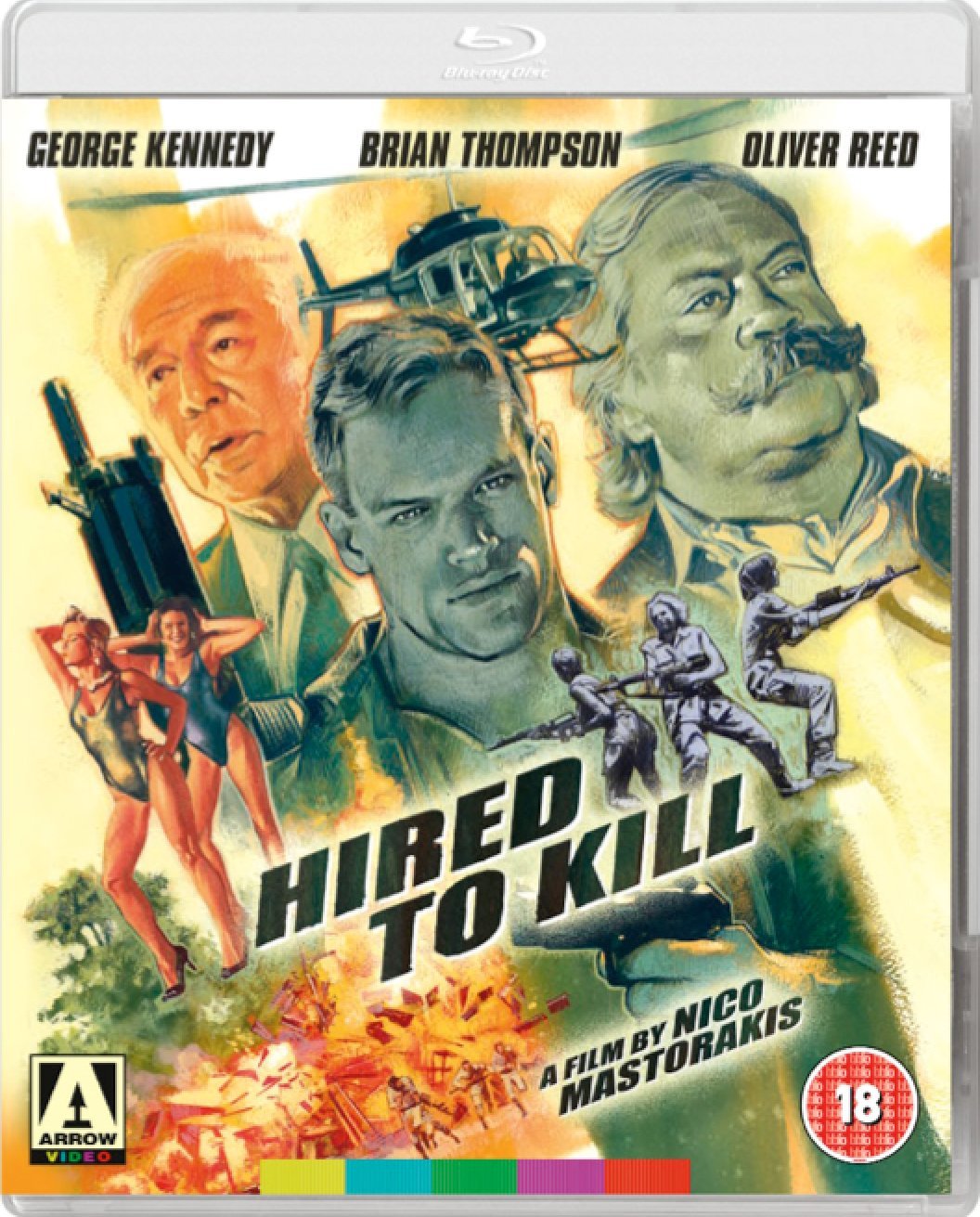 Hired to Kill (Nico Mastorakis & Peter Radar, 1990) 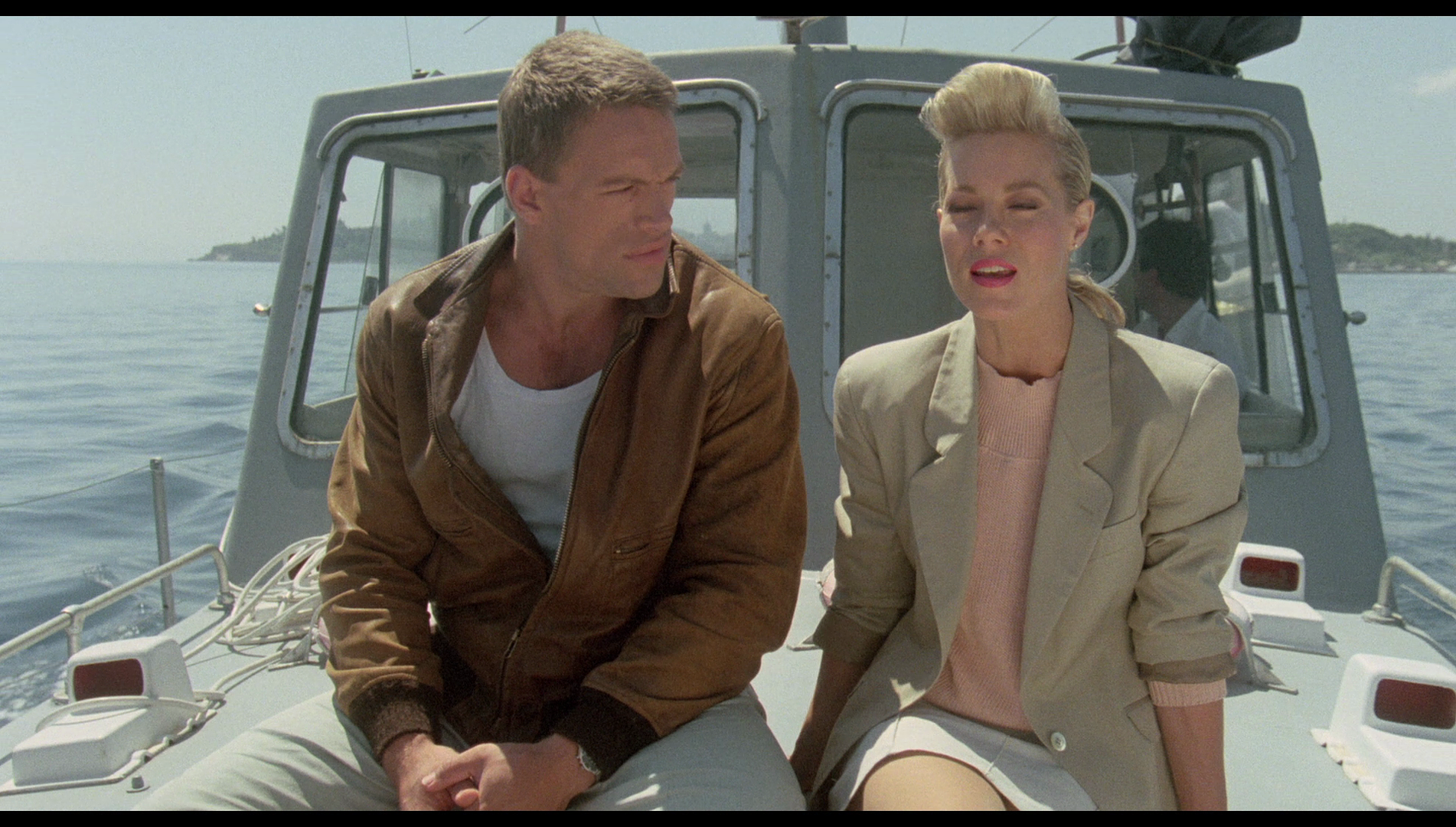 Hired by shady businessman Thomas (George Kennedy), mercenary Frank Ryan (Brian Thompson) is tasked with freeing a revolutionary, Rallis (aka The Brother; Jose Ferrer), from the Mediterranean state of Cypra. Rallis is the key to overthrowing the tyrannical regime that is overseen by Michael Bartos (Oliver Reed, with the most fabulous of moustaches); Rallis is the figurehead of the revolution, and his release, Thomas argues, would spur the people on to toppling Bartos. Hired by shady businessman Thomas (George Kennedy), mercenary Frank Ryan (Brian Thompson) is tasked with freeing a revolutionary, Rallis (aka The Brother; Jose Ferrer), from the Mediterranean state of Cypra. Rallis is the key to overthrowing the tyrannical regime that is overseen by Michael Bartos (Oliver Reed, with the most fabulous of moustaches); Rallis is the figurehead of the revolution, and his release, Thomas argues, would spur the people on to toppling Bartos.
To achieve the aim of releasing Rallis from the island jail on which he is held, Ryan is forced to work with a former colleague, Sheila (Barbara Lee Alexander), whose mistake on a previous mission Ryan blames for the deaths of several of his friends. Together, Ryan and Sheila begin to gather together a team of female mercenaries, almost all of whom have been incarcerated and are tempted into co-operating owing to promises of their freedom: Sivi (Kim Lonsdale) is approached by Ryan and Sheila in a Turkish female prison, where Sivi has been imprisoned following her arrest for smuggling heroin; Joanna (Jordana Capri), an incarcerated defector, is similarly enticed into assisting Ryan in his mission; and Katrina (Penelope Reed), an expert with a knife who has been imprisoned on Sardinia following her murder of a rapist, is also recruited by Ryan and Sheila. The odd one out is Dahlia (Jude Musetter), a former Mossad agent now masquerading as a fashion photographer, who Ryan blackmails into co-operating by threatening to reveal her new identity to the PLO. Ryan trains the women in combat techniques, whilst they are also trained to act like fashion models. Masquerading as a fashion designer, Cecil Thornton, Ryan and his team infiltrate Cypra and meet with Bartos: Ryan’s team’s cover during the operation, their ‘in’ with Bartos and his group, will be that they are in the country to promote Cecil Thornton’s new fashion line. However, Bartos’ suggestion that his young lover Ana (Michelle Moffett), who aspired to be a model, accompany Ryan’s group seems to scupper the plans to free Rallis. 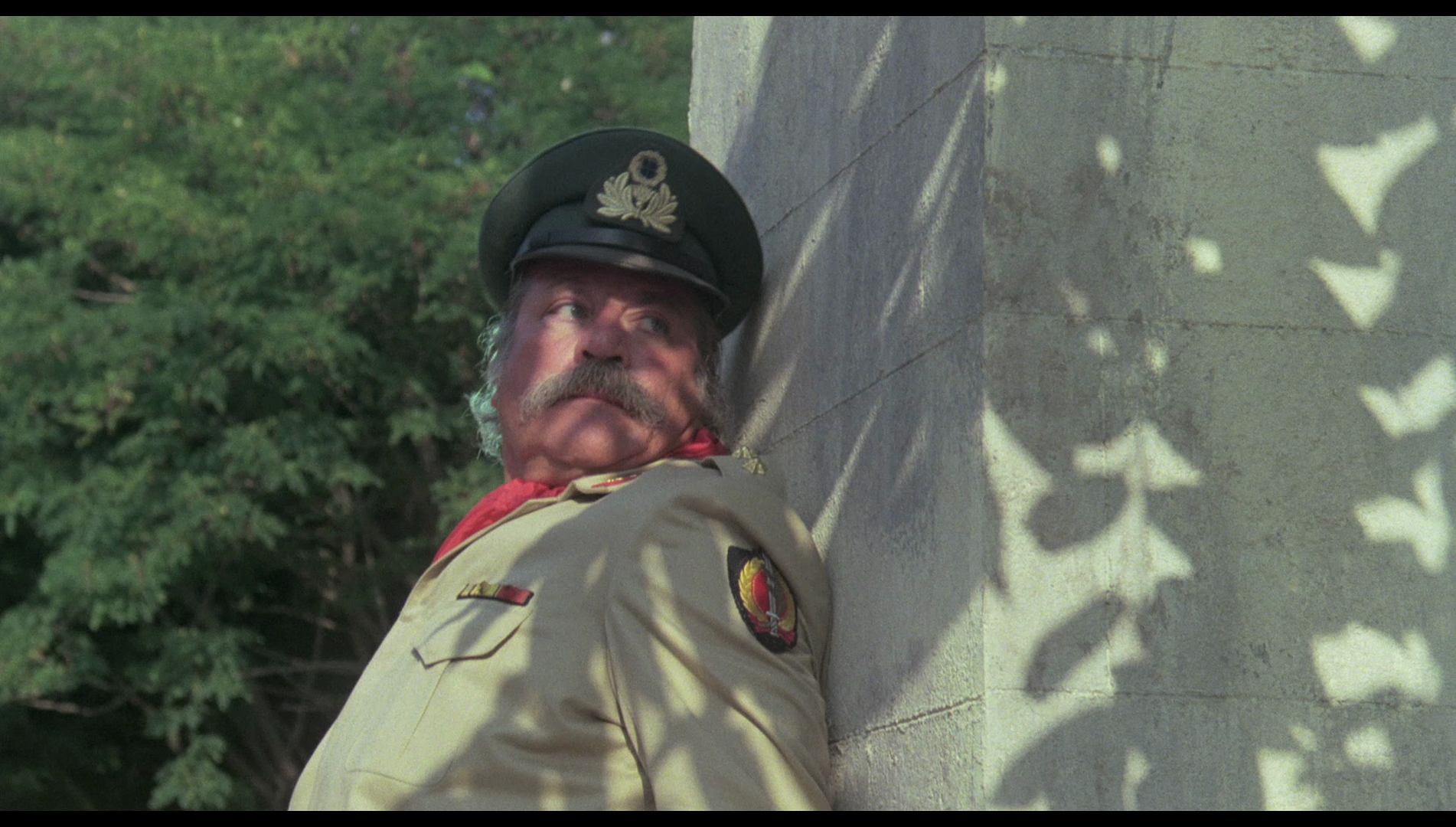 As the above synopsis might suggest, there’s more than a little of Mission: Impossible (CBS, 1966-73) in Hired to Kill (Nico Mastorakis, 1990), in the sense that the narrative focuses on the selection of an elite team who are sent to release an imprisoned revolutionary in order to topple a corrupt regime in a fictional country. Furthermore, in terms of the film’s depiction of Ryan and Sheila’s recruitment of their team from prisons and the aggressive training regime through which Ryan puts them (forcing the women to crawl under barbed wire whilst firing a machine gun above them), there’s more than a little of Robert Aldrich’s The Dirty Dozen (1967) too. In fact, in its focus on a team of female mercenaries who are (mostly) dragged out of jail and must masquerade as fashion models in order to overthrow a corrupt regime, it’s tempting to read the film as a parody of the ‘men on a mission’ subgenre that is embodied by Aldrich’s film and has been recently revived for a post-postmodern audience with Sylvester Stallone’s The Expendables (2010) and its sequels. As the above synopsis might suggest, there’s more than a little of Mission: Impossible (CBS, 1966-73) in Hired to Kill (Nico Mastorakis, 1990), in the sense that the narrative focuses on the selection of an elite team who are sent to release an imprisoned revolutionary in order to topple a corrupt regime in a fictional country. Furthermore, in terms of the film’s depiction of Ryan and Sheila’s recruitment of their team from prisons and the aggressive training regime through which Ryan puts them (forcing the women to crawl under barbed wire whilst firing a machine gun above them), there’s more than a little of Robert Aldrich’s The Dirty Dozen (1967) too. In fact, in its focus on a team of female mercenaries who are (mostly) dragged out of jail and must masquerade as fashion models in order to overthrow a corrupt regime, it’s tempting to read the film as a parody of the ‘men on a mission’ subgenre that is embodied by Aldrich’s film and has been recently revived for a post-postmodern audience with Sylvester Stallone’s The Expendables (2010) and its sequels.
Hired to Kill was shot on Corfu, and reputedly during the production an inebriated Oliver Reed headbutted Mastorakis in a disagreement over Reed’s role in the film (Sellers, 2013: np). Mastorakis later compared the experience of working with Reed, who could veer from drunk and aggressive to affable and polite, with ‘chew[ing] razor blades’ (Mastorakis, quoted in ibid.). As with a number of action films made in the fallout from the Iran-Contra scandal of the mid-1980s, Hired to Kill is subtly critical of American involvement in foreign affairs. Ryan is a cynical meat-head who is hired by Thomas. As played by George Kennedy, Thomas is a shady figure of authority, who is open with Ryan about his backers’ intention to topple Bartos’ regime. However, Thomas claims not to be associated with the government. He tells Thomas that the group he represents isn’t the CIA, though ‘We let them [the CIA] run errands for us once in a while, but I find them plungy and anachronistic’. When, later in the film, Thomas tells Ryan – in a manner familiar from the aforementioned Mission: Impossible series – that if Ryan’s team fails to achieve their objective, Thomas will disavow any knowledge of Ryan’s actions, Ryan asks Thomas, ‘Are you sure you’re not a politician?’ ‘I’m much worse’, Thomas says, ‘I’m a businessman’. 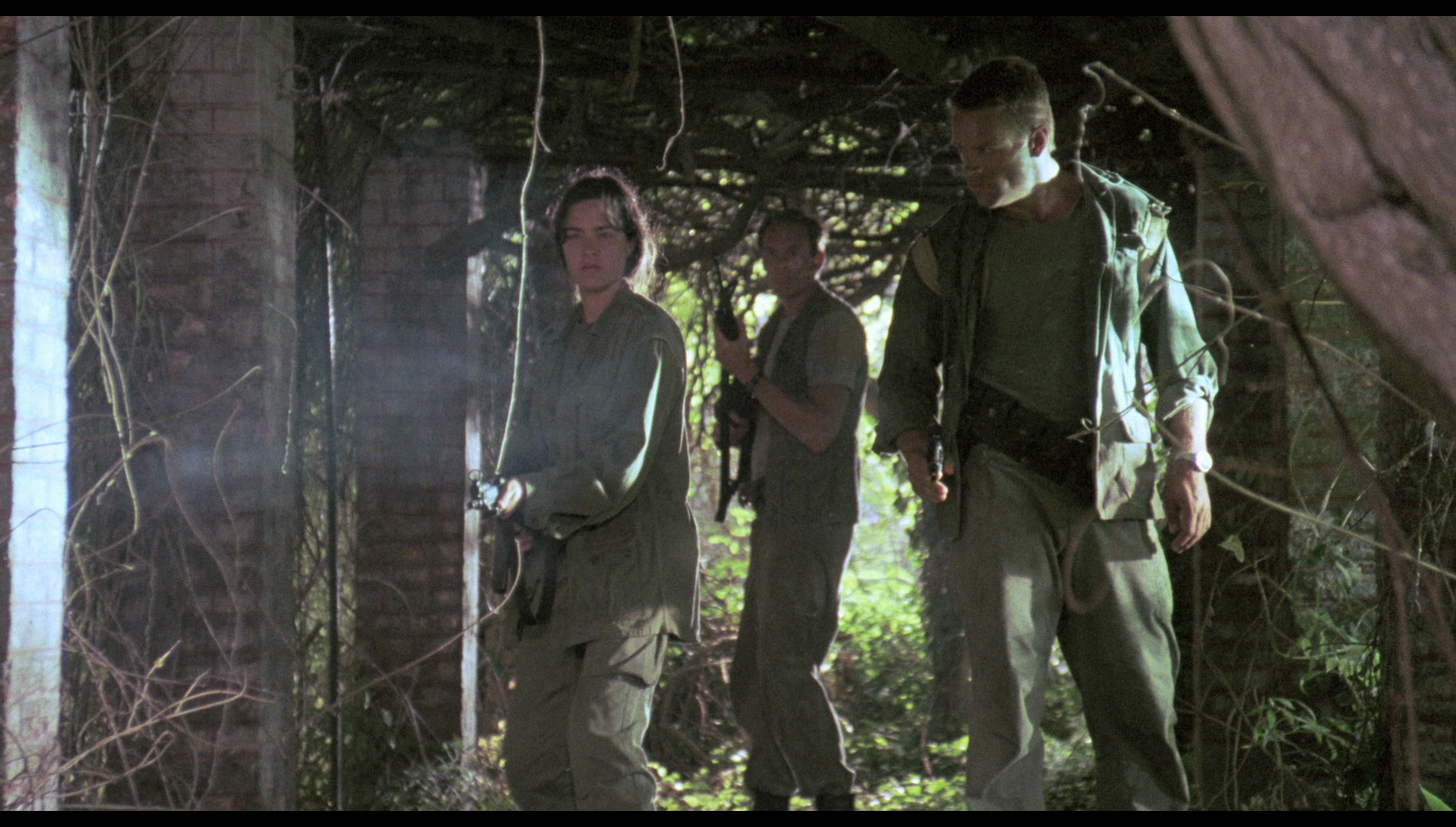 The aims of the people Thomas represents aren’t political: ‘Our group has no political motives’, he asserts; to this, Ryan responds, ‘In that country [Cypra], taking a dump is political’. In a throwaway line of dialogue that references American involvement in the kind of regime change that would escalate with Operation Just Cause and Operation Desert Storm, Thomas declares that ‘The irony is, we put the government [Bartos’ regime] there’. ‘So what happened?’, Ryan asks, ‘Bad investment?’ ‘Greed is what happened’, Thomas tells him, ‘The colonels sucked up all the cash and bankrupt the country in three years’. Thomas’ plan is to support the revolutionaries and overthrow the Bartos regime with yet another: ‘The country’s ready to blow’, he says, ‘All we need is a match to light the fire’. Ryan refuses to be drawn into the politics of the situation in Cypra. He asks the team’s contact within the revolutionaries on the island, Tara (Angela Gerekou), ‘If your country is so hell-bent on revolution, why don’t you do this [free Rallis] for yourselves?’ Tara responds by suggesting that ‘Our people are useless without a leader’, before assuring Ryan, ‘Don’t worry, you won’t be mistaken for an idealist’. Later, Ryan suggests that the revolution will achieve nothing: that the regime which it will replace Bartos’ with will be different in name only. ‘As soon as he’s cut a few throats and takes charge’, Ryan declares in reference to Rallis, ‘he’ll be taking two baths a day in Bartos’ own tub’. Ana tries to provoke Ryan into discarding his macho façade and offering a more human response to the realities of life in Cypra: ‘Underneath it all, you do care, don’t you?’, she asks. ‘Let me give you a lesson in caring’, Ryan asserts before expounding upon his cynical philosophy, ‘Man kills for money and power. That’s the way it’s always been and that’s the way it’ll always be. Causes, revolutions, country. It’s all icing on the cake. Watch your revolutionary buddies when they’re in charge. They’ll kill each other and probably you – for money and power’. He ends his rant by declaring, ‘I’m a hired hand, that’s all. There’s nothing wrong with that. Some of us get paid to fight outer people’s wars; others get paid to sleep with pigs like Michael Bartos. We’re all whores’. The aims of the people Thomas represents aren’t political: ‘Our group has no political motives’, he asserts; to this, Ryan responds, ‘In that country [Cypra], taking a dump is political’. In a throwaway line of dialogue that references American involvement in the kind of regime change that would escalate with Operation Just Cause and Operation Desert Storm, Thomas declares that ‘The irony is, we put the government [Bartos’ regime] there’. ‘So what happened?’, Ryan asks, ‘Bad investment?’ ‘Greed is what happened’, Thomas tells him, ‘The colonels sucked up all the cash and bankrupt the country in three years’. Thomas’ plan is to support the revolutionaries and overthrow the Bartos regime with yet another: ‘The country’s ready to blow’, he says, ‘All we need is a match to light the fire’. Ryan refuses to be drawn into the politics of the situation in Cypra. He asks the team’s contact within the revolutionaries on the island, Tara (Angela Gerekou), ‘If your country is so hell-bent on revolution, why don’t you do this [free Rallis] for yourselves?’ Tara responds by suggesting that ‘Our people are useless without a leader’, before assuring Ryan, ‘Don’t worry, you won’t be mistaken for an idealist’. Later, Ryan suggests that the revolution will achieve nothing: that the regime which it will replace Bartos’ with will be different in name only. ‘As soon as he’s cut a few throats and takes charge’, Ryan declares in reference to Rallis, ‘he’ll be taking two baths a day in Bartos’ own tub’. Ana tries to provoke Ryan into discarding his macho façade and offering a more human response to the realities of life in Cypra: ‘Underneath it all, you do care, don’t you?’, she asks. ‘Let me give you a lesson in caring’, Ryan asserts before expounding upon his cynical philosophy, ‘Man kills for money and power. That’s the way it’s always been and that’s the way it’ll always be. Causes, revolutions, country. It’s all icing on the cake. Watch your revolutionary buddies when they’re in charge. They’ll kill each other and probably you – for money and power’. He ends his rant by declaring, ‘I’m a hired hand, that’s all. There’s nothing wrong with that. Some of us get paid to fight outer people’s wars; others get paid to sleep with pigs like Michael Bartos. We’re all whores’.
For his part, Ryan is a macho cardboard cut-out action hero, and the film offers a bizarre juxtaposition of this archetype with the female action heroes of Ryan’s team. From his introduction, Ryan is depicted so hyperbolically in terms of his encapsulation of the traits of action film heroes of the 1980s as to seem deliberately to parody the types of characters played by Schwarzenegger and Stallone and their various imitators. (That said, 1980s action films aren’t noted for their subtlety, and in their exaggerated characteristics and emphasis on caricature, they often verge on self-parody, as any viewer of Mark L Lester’s Commando, 1986, George P Cosmatos’ Cobra, 1986, or Joseph Zito’s Invasion USA, 1985, will recognise.) Ryan is introduced on his boat, where he is reclining and resting. The telephone rings; Ryan pulls out a ridiculously overpowered pistol and shoots the telephone to stop the noise, allowing him to return to his rest; however, this is interrupted by men wearing suits and sunglasses, who step onto his boat and tell Ryan sternly, ‘Wake up, Mr Ryan. You’re late for your appointment’. Later, Ryan is shown to be incredibly bull-headed when Ana’s associate Louis saves Katrina, who has accidentally stood on a land mine whilst the team cross a minefield in their approach to the prison in which Rallis is held. Ryan chastises Louis for his supposedly reckless action. ‘Give him a break’, Joanna declares, ‘He’s a brave guy’. ‘Fuck brave’, Ryan asserts coldly, ‘Brave is for fairy tales. This is real’. At one point, Thomas even makes a strange allusion to the era of Brat Pack actors by referring to Ryan as a member of ‘the brat pack-type mercenaries’. 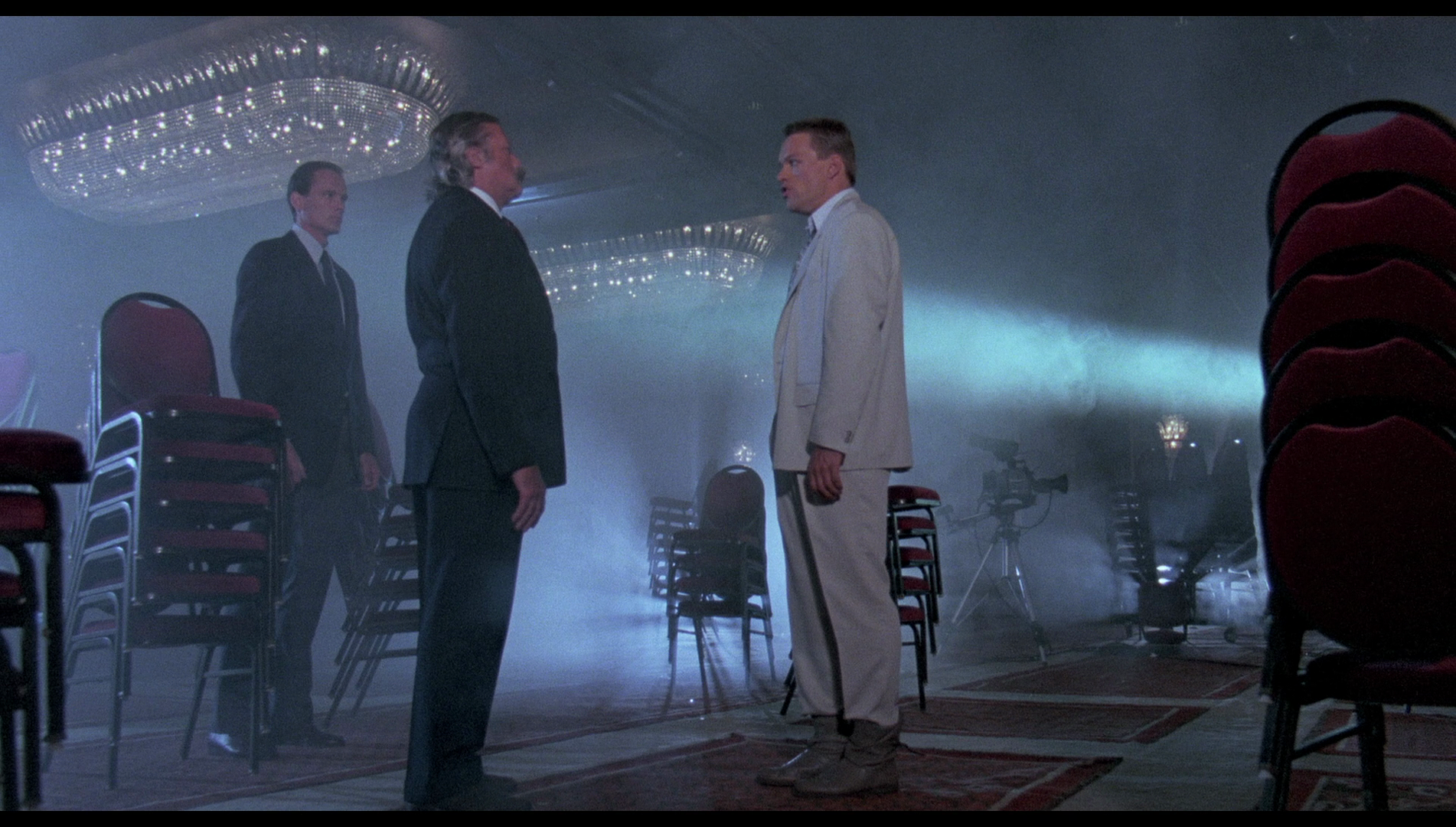 The film is filled with the iconography of the 1980s: beefy action heroes; lots of action; fashion shoots in the manner of Duran Duran’s ‘Girls on Film’ video. The picture places as much emphasis on Ryan’s team’s rehearsals as fashion models as on their preparations for combat. In the build-up to the mission itself, there are montages typical of action films of the era showing the women training for combat, and these are juxtaposed with montages showing them practising their modeling skills and putting on makeup: the enacting of femininity is contrasted via editing with the women’s preparations for their stereotypically male roles as combatants. The battlefield and the catwalk thus become confused: both are suggested to be spaces in which carefully rehearsed roles are performed. The film’s assertion of a ‘deadly’ femininity (‘Dressed to Kill’ would have been a more apt title, had it not already been used for De Palma’s 1980 film) is heightened when the character of Ana is introduced. Ana is Bartos’ love; Bartos insists that Ana join Ryan’s team, and when Sheila expresses a concern that Ana may be spying on them for Bartos, Ryan proposes using Ana to send false information back to her lover. However, Ana eventually reveals herself to be a ‘plant’ by Thomas, there to betray Bartos and assist the revolutionaries. Her femininity is the perfect disguise: ‘Don’t worry about my cover’, Ana tells Ryan, ‘It’s true what they say about love being blind. The smartest and most powerful are vulnerable’. In a later sequence, Bartos’ guards accompany Ryan’s team on what Bartos believes to be a photoshoot in a set of caves. In a foregrounding of the femme fatale archetype, the women pretend to seduce the guards, separating them from one another before eliminating them. The film is filled with the iconography of the 1980s: beefy action heroes; lots of action; fashion shoots in the manner of Duran Duran’s ‘Girls on Film’ video. The picture places as much emphasis on Ryan’s team’s rehearsals as fashion models as on their preparations for combat. In the build-up to the mission itself, there are montages typical of action films of the era showing the women training for combat, and these are juxtaposed with montages showing them practising their modeling skills and putting on makeup: the enacting of femininity is contrasted via editing with the women’s preparations for their stereotypically male roles as combatants. The battlefield and the catwalk thus become confused: both are suggested to be spaces in which carefully rehearsed roles are performed. The film’s assertion of a ‘deadly’ femininity (‘Dressed to Kill’ would have been a more apt title, had it not already been used for De Palma’s 1980 film) is heightened when the character of Ana is introduced. Ana is Bartos’ love; Bartos insists that Ana join Ryan’s team, and when Sheila expresses a concern that Ana may be spying on them for Bartos, Ryan proposes using Ana to send false information back to her lover. However, Ana eventually reveals herself to be a ‘plant’ by Thomas, there to betray Bartos and assist the revolutionaries. Her femininity is the perfect disguise: ‘Don’t worry about my cover’, Ana tells Ryan, ‘It’s true what they say about love being blind. The smartest and most powerful are vulnerable’. In a later sequence, Bartos’ guards accompany Ryan’s team on what Bartos believes to be a photoshoot in a set of caves. In a foregrounding of the femme fatale archetype, the women pretend to seduce the guards, separating them from one another before eliminating them.
The relationship between the genders, and attitudes towards gender relations, are addressed by the script in a very overt, selfconscious manner. Thomas’ plan is laid out for Ryan: ‘So just get in the driver’s seat and drive’, Thomas tells Ryan, in reference to how detailed the plan is. Shortly afterwards, Sheila reinforces this by telling Ryan how ‘perfect’ Thomas’ plan is. ‘Nothing is perfect where women are involved’, Ryan responds. ‘That’s probably the most chauvinistic drivel I’ve ever heard’, Sheila tells him. ‘From Eve to Margaret Thatcher, you’ve managed to screw up history’, Ryan responds coldly. When Ryan first assembles his all-female team, he tells them, in reference to their dual role as fashion models/combatants, ‘You gotta look good, move well and kill quick’; he then asserts, in reference to his feelings of betrayal towards Sheila (whose fumbling during a previous operation led to the deaths of several other members of Ryan’s team), ‘I don’t like working with women’. 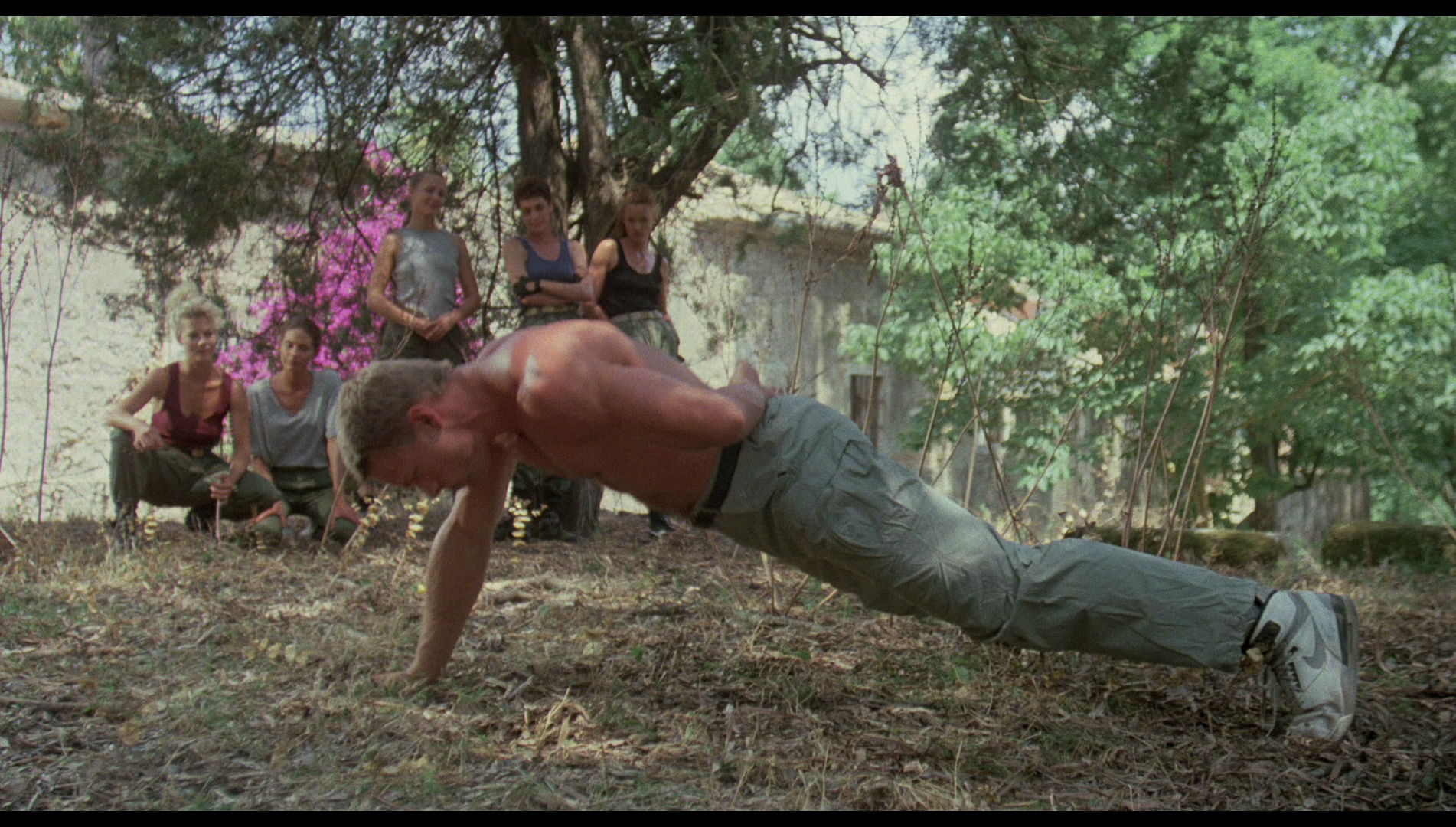 Some striking compositions are achieved when the women model for Bartos, including the women, all wearing sunglasses, posing on two parallel escalators. These images are reminiscent of the fashion photography of the era, including the work of photographers like Guy Bourdin. In line with the photography of contemporaneous photographers such as Herb Ritts and Bruce Weber, Hired to Kill also features sequences in which the typically ‘male’ gaze of the camera is turned upon Brian Thompson, objectifying him in a way that feels very selfconscious. After Ryan trains the women, with him gazing over them from a position of male authority as they prepare for combat and for their roles as fashion models, he is shown exercising shirtless, his body on display for the women who watch him. As if to offset this objectification of the male body, there are some quite crude (and cruel) jokes about homosexuality here and there. When Thomas tells Ryan he must masquerade as Cecil Thornton, a fashion designer, Ryan asks him, ‘You want me to be some faggot designer?’ ‘Faggot?’, Thomas questions, ‘Yes, very good’. The ‘panic’ about homosexuality comes to a dryly funny climax when Bartos decides to ‘test’ Ryan, whose masquerade as the gay fashion designer Cecil Thornton Bartos is beginning to question. Alone with Ryan and Ana, Bartos tells Ryan ‘You fascinate me, Mr Thornton […] In the way that you surround yourself with beautiful women, but you never avail yourself of their delights. Forgive my naivete, but I find this very strange, very unusual’. ‘So did my parents’, Ryan responds, ‘Please forgive me, but my sensual tastes lie… in other areas’. Bartos exposes Ana’s breasts to Ryan, in an attempt to provoke a reaction from him, asking Ryan if there is ‘anything here that you want’. ‘Another glass of wine’, Ryan asserts, refusing to take Bartos’ bait. Bartos dismisses Ana and approaches Ryan before suddenly grabbing Ryan’s crotch, clearly to see if Ana’s partial nudity has aroused him. Ryan responds by kissing Bartos on the mouth, with the intention of proving his cover by showing that his physical response is to Bartos rather than to Ana. In this scene, the film seems to offer a very self-aware payoff to the often unintentional homoerotic subtexts of many 1980s action pictures. Some striking compositions are achieved when the women model for Bartos, including the women, all wearing sunglasses, posing on two parallel escalators. These images are reminiscent of the fashion photography of the era, including the work of photographers like Guy Bourdin. In line with the photography of contemporaneous photographers such as Herb Ritts and Bruce Weber, Hired to Kill also features sequences in which the typically ‘male’ gaze of the camera is turned upon Brian Thompson, objectifying him in a way that feels very selfconscious. After Ryan trains the women, with him gazing over them from a position of male authority as they prepare for combat and for their roles as fashion models, he is shown exercising shirtless, his body on display for the women who watch him. As if to offset this objectification of the male body, there are some quite crude (and cruel) jokes about homosexuality here and there. When Thomas tells Ryan he must masquerade as Cecil Thornton, a fashion designer, Ryan asks him, ‘You want me to be some faggot designer?’ ‘Faggot?’, Thomas questions, ‘Yes, very good’. The ‘panic’ about homosexuality comes to a dryly funny climax when Bartos decides to ‘test’ Ryan, whose masquerade as the gay fashion designer Cecil Thornton Bartos is beginning to question. Alone with Ryan and Ana, Bartos tells Ryan ‘You fascinate me, Mr Thornton […] In the way that you surround yourself with beautiful women, but you never avail yourself of their delights. Forgive my naivete, but I find this very strange, very unusual’. ‘So did my parents’, Ryan responds, ‘Please forgive me, but my sensual tastes lie… in other areas’. Bartos exposes Ana’s breasts to Ryan, in an attempt to provoke a reaction from him, asking Ryan if there is ‘anything here that you want’. ‘Another glass of wine’, Ryan asserts, refusing to take Bartos’ bait. Bartos dismisses Ana and approaches Ryan before suddenly grabbing Ryan’s crotch, clearly to see if Ana’s partial nudity has aroused him. Ryan responds by kissing Bartos on the mouth, with the intention of proving his cover by showing that his physical response is to Bartos rather than to Ana. In this scene, the film seems to offer a very self-aware payoff to the often unintentional homoerotic subtexts of many 1980s action pictures.
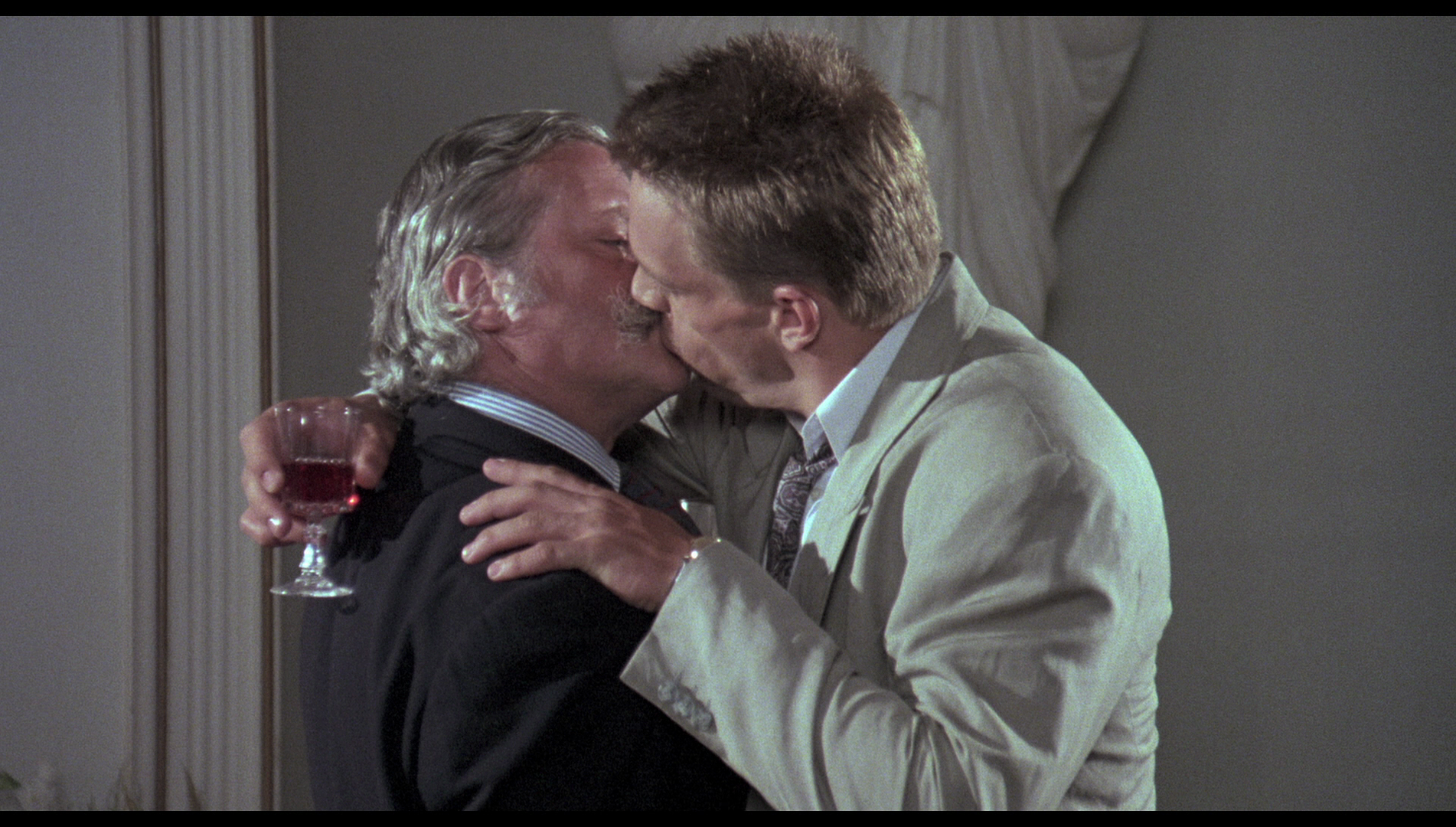 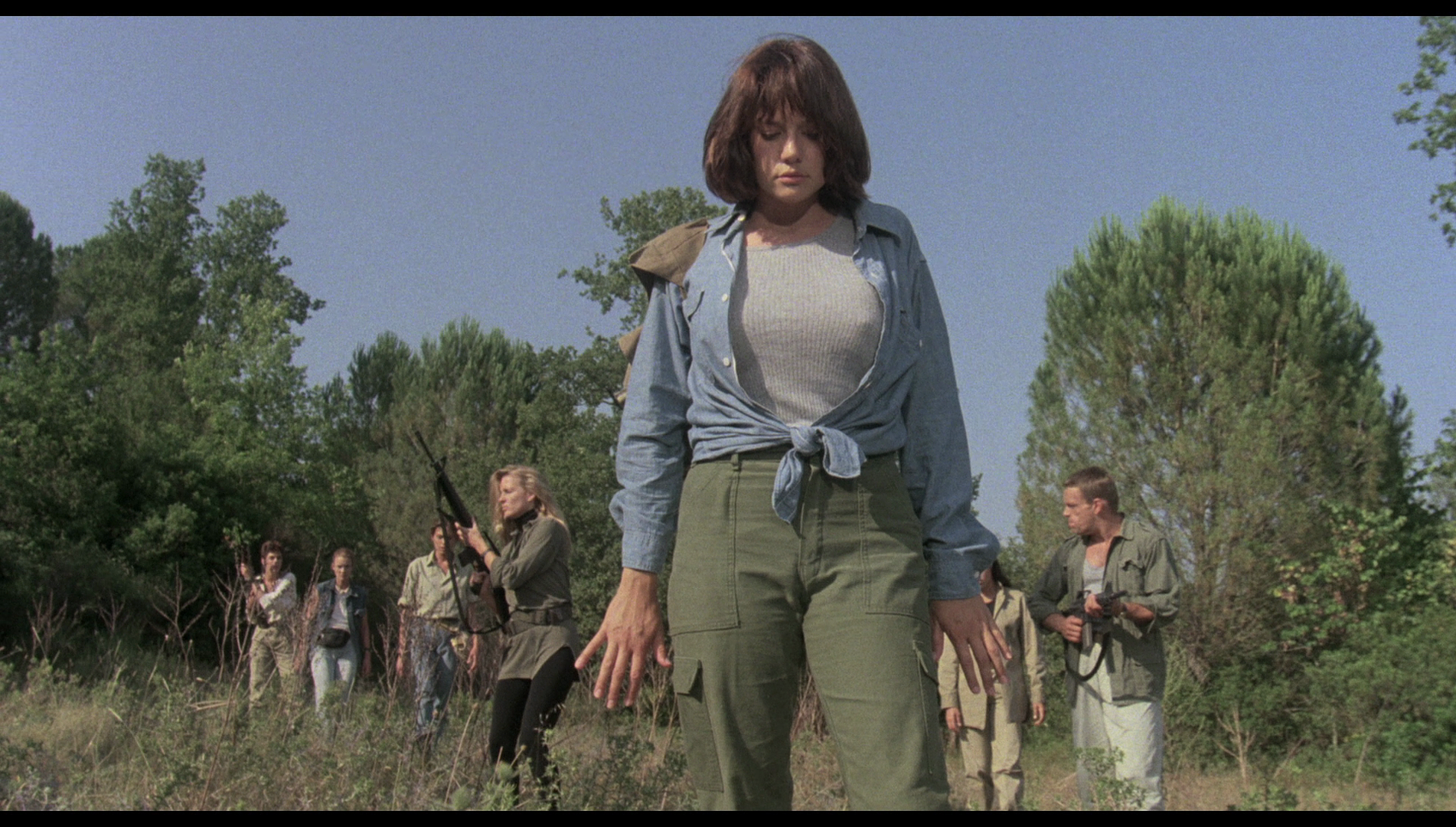 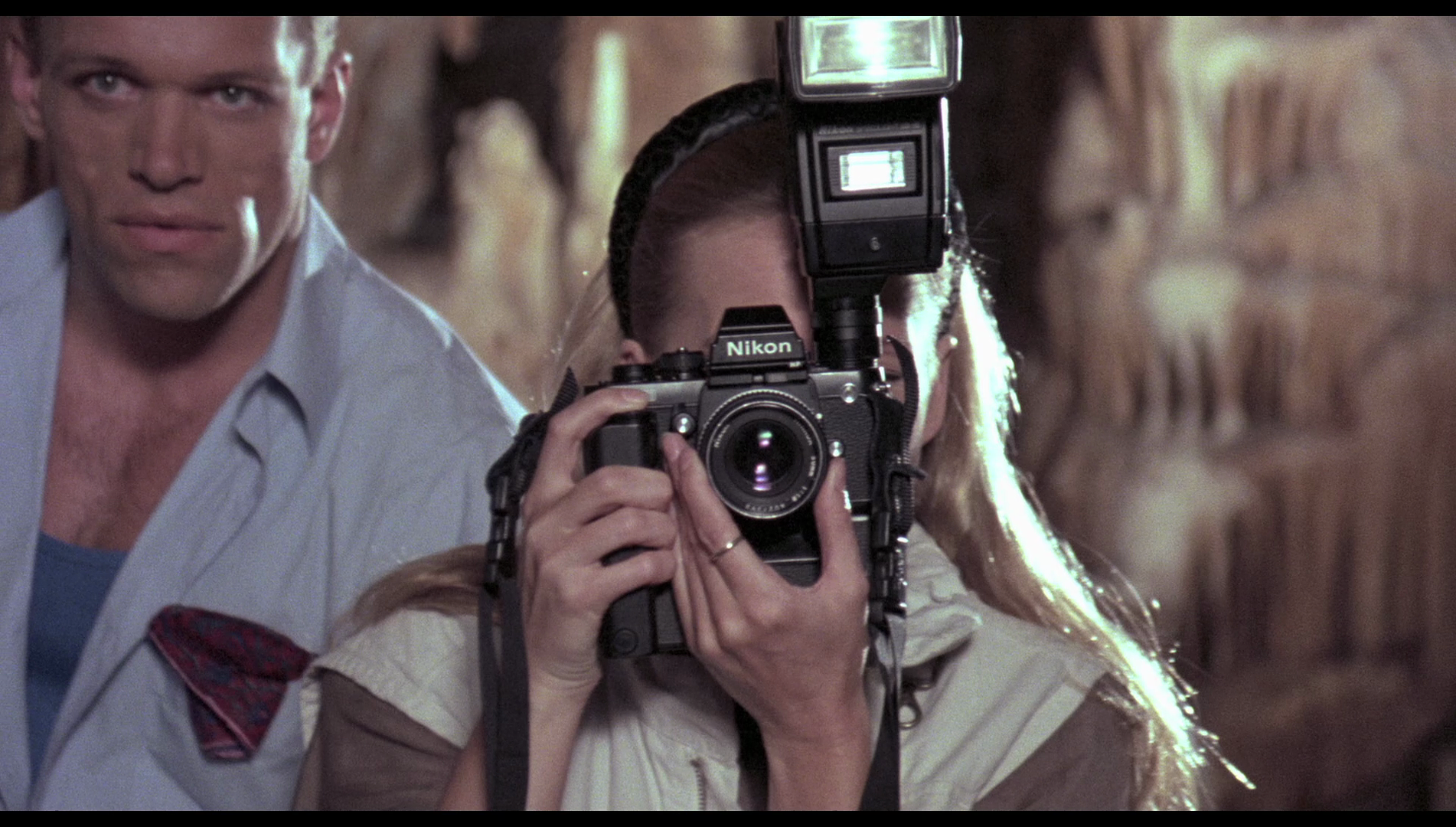
Video
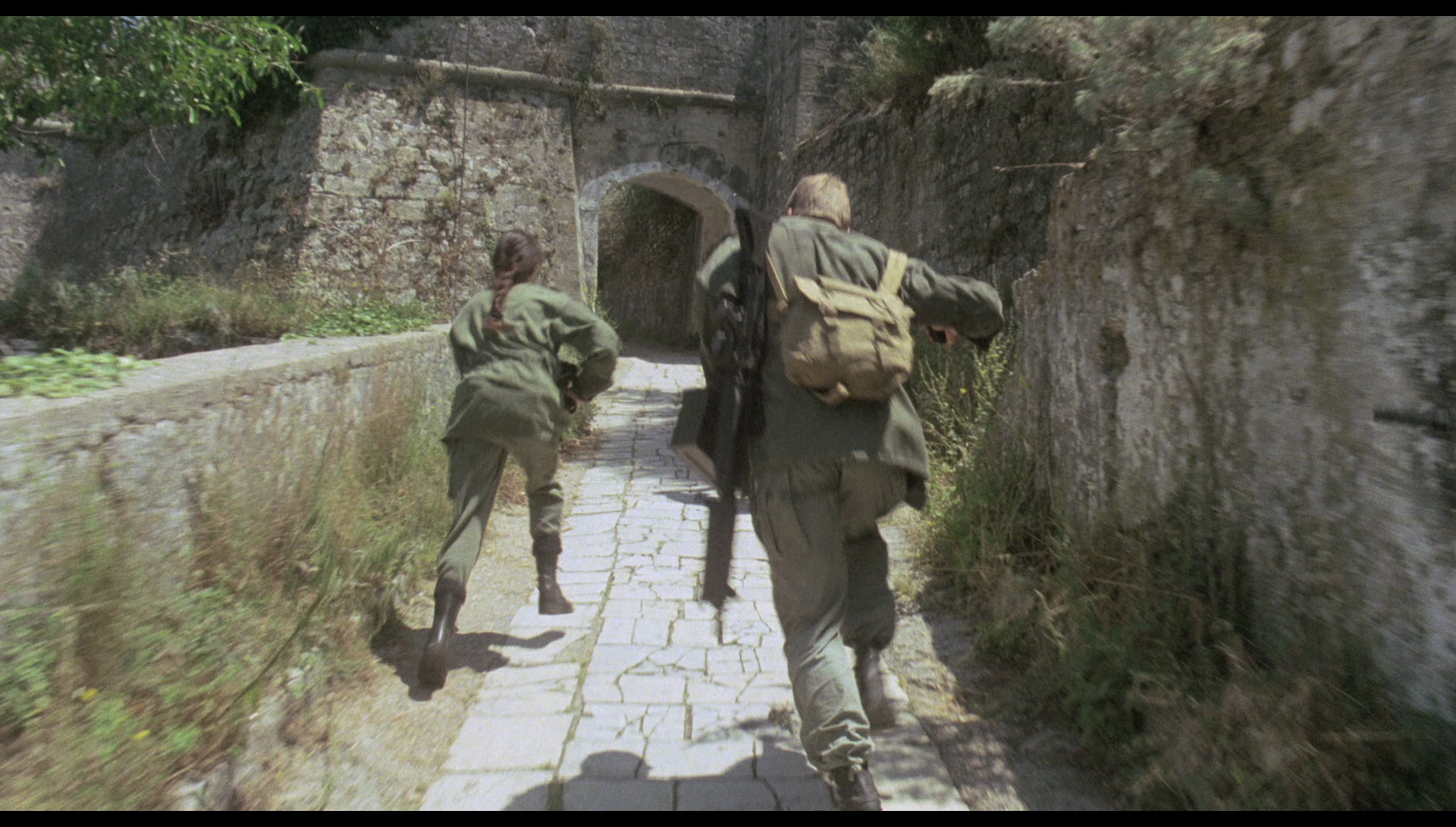 Taking up 26Gb of space on its disc, this presentation of the film is in 1080p and uses the AVC codec. The film is presented in its original aspect ratio of 1.85:1 and is uncut. The running time is 96:27 mins. Taking up 26Gb of space on its disc, this presentation of the film is in 1080p and uses the AVC codec. The film is presented in its original aspect ratio of 1.85:1 and is uncut. The running time is 96:27 mins.
The presentation is based on a 4k scan of a 35mm interpositive, and is approved by Mastorakis himself. A good level of detail is present throughout the film. The harsh sunlight of the Mediterranean locations result in a ‘bleached’ appearance to some scenes, especially those which feature the strong Mediterranean sunlight streaming through windows, resulting in a very diffused lighting scheme; this, of course, is a characteristic of the original photography and is down to the lighting conditions during the production. The presentation evidences good contrast, with deep, rich black where they’re needed. The source material is clean and free from damage and debris, and this presentation is carried through a good encode to disc which, though a little soft in places (especially in the aforementioned scenes which feature diffused light), seems to retain the structure of 35mm film, offering the viewer an organic, filmlike viewing experience. 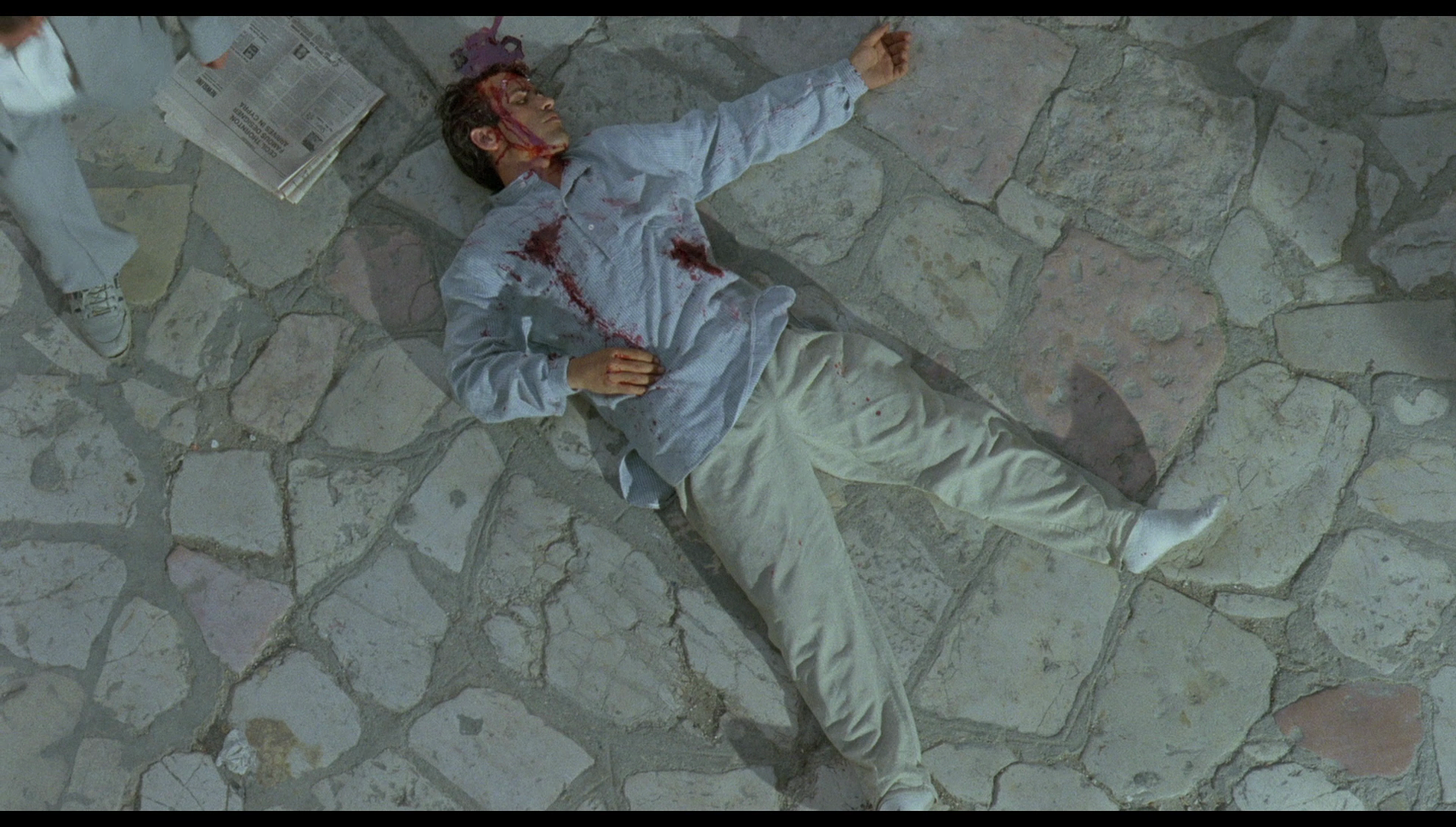 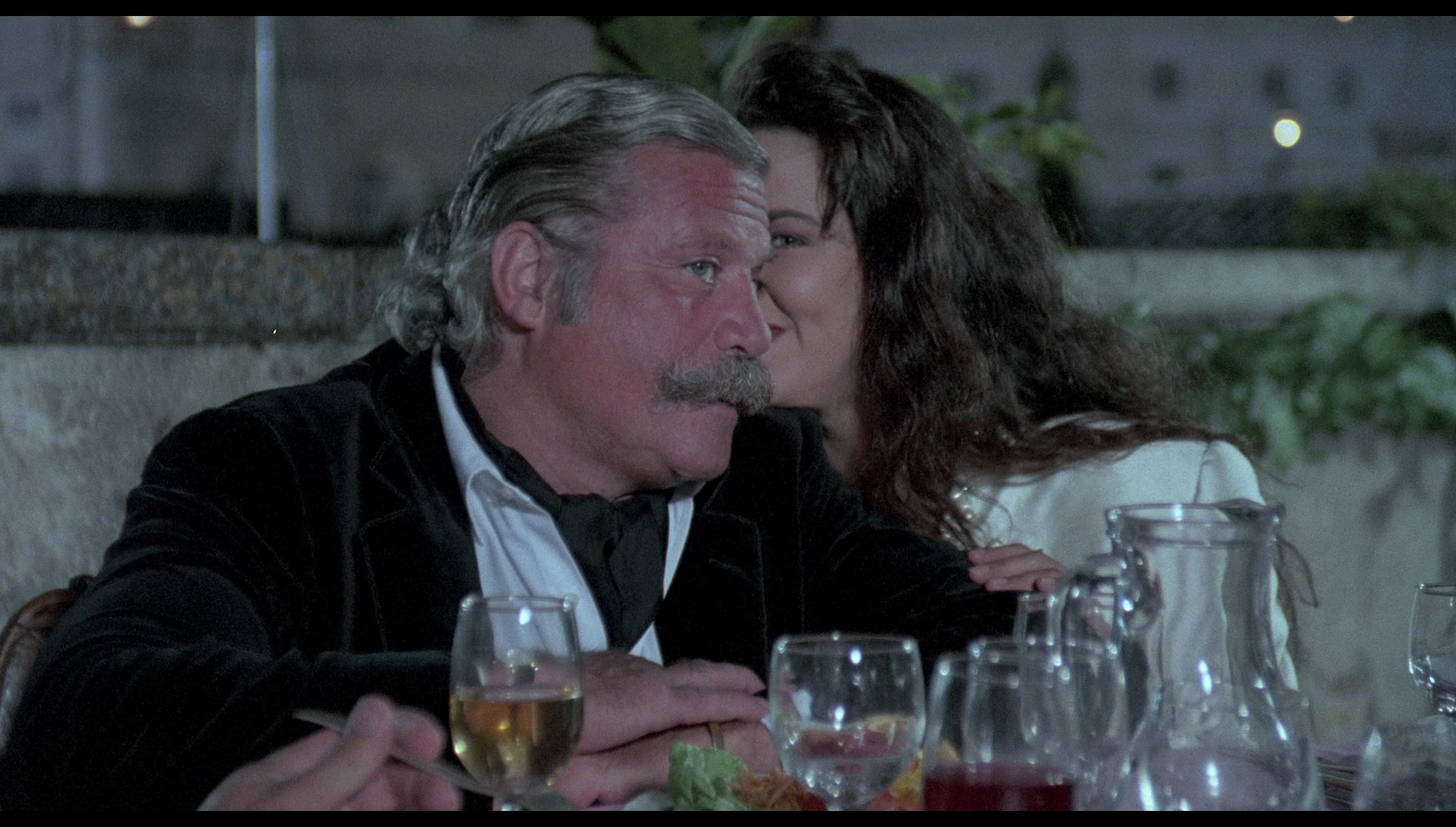 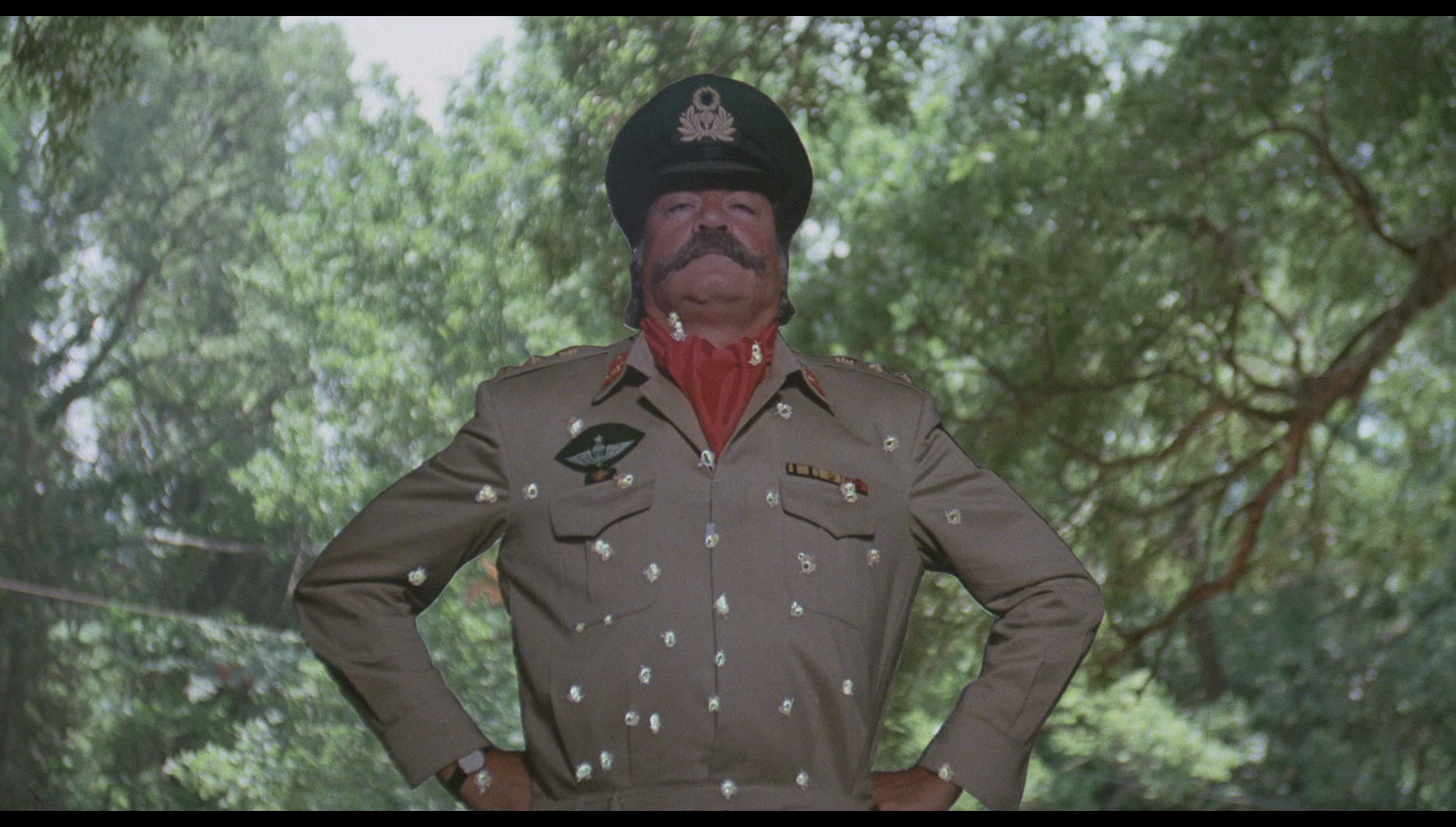
Audio
There are two audio options: a lossless LPCM 2.0 stereo track and a lossy Dolby Digital 5.1 track. The latter features some bold sound separation but is noticeable clipped and compressed, whereas the former lacks the artificial sound separation of the lossy track but is much more rich and fll-bodied, with excellent range that is evidenced from the opening synth score to the climactic action scenes. Optional English subtitles for the Hard of Hearing are provided.
Extras
The disc includes: 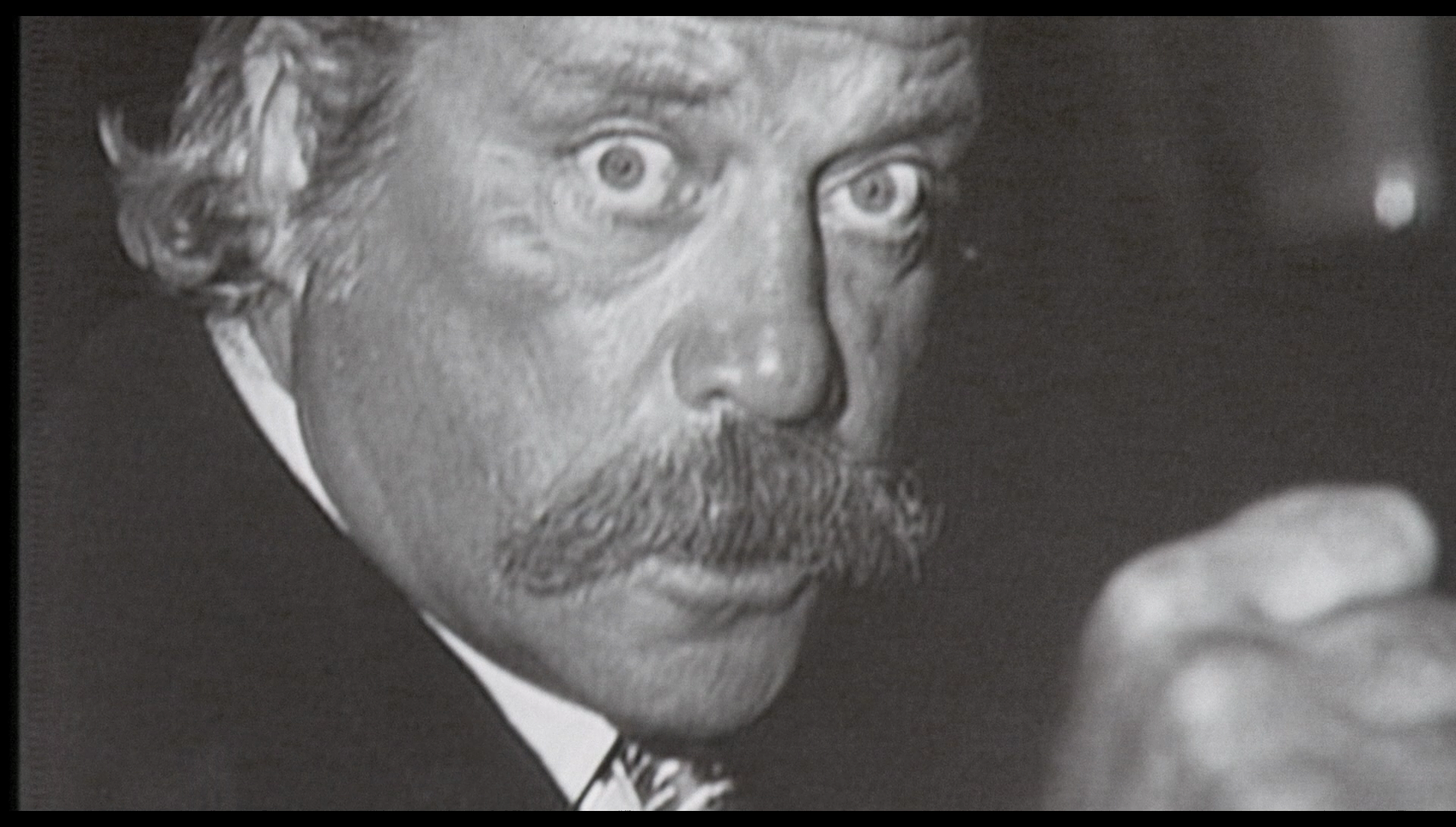 - an audio commentary with the film’s editor Barry Zetlin, moderated by Michael Felsher. This is a fascinating commentary in which Zetlin talks about his work on Hired to Kill but also reflects in detail on many of the other films which he edited. - an audio commentary with the film’s editor Barry Zetlin, moderated by Michael Felsher. This is a fascinating commentary in which Zetlin talks about his work on Hired to Kill but also reflects in detail on many of the other films which he edited.
- ‘Hired to Direct’ (27:26). This interview with Nico Mastorakis focuses on the making of the film. He describes the film as ‘a kind of Magnificent Seven with women’. The film was originally scripted to take place in a Latin American country, but in rewrites the story was relocated to the fictional country of Cypra. The film was originally titled ‘Freedom or Death’, but Hired to Kill was felt to be a more commercial title. Mastorakis talks about the film’s release and reception, and discusses his issues with working with Oliver Reed. He refers to George Kennedy and Jose Ferrer as ‘the very definition of the word “gentleman”’. Reed, Mastorakis argues, was another story, and the director comments on Reed’s on-set behaviour in some detail: ‘When he was drunk, he was a tyrant’, Mastorakis asserts, but ‘When he was sober, he was nice, he was an excellent actor, he was a gentleman to everyone. But that was very rare’. During the filming of the climax, Mastorakis says, a drunken Reed urinated in the middle of a take. Mastorakis also talks about the death of stuntman Clint Carpenter during the production of the film. - ‘Undercover Mercenary’ (17:33). Here, in a new interview, Brian Thompson discusses the film. Thompson talks about his career to that point, including how he came to work as an actor. He reflects on his relationship with Mastorakis, who at the time of the shooting of Hired to Kill was Thompson’s father-in-law. Thompson reflects in some detail on the shooting of the picture, offering a different version of the story told by Mastorakis about Oliver Reed’s random act of urination during the shooting of a scene – in protest at Mastorakis’ suggestion that Reed’s character should drop his pistol in surrender to the revolutionaries. Thompson also reflects on the on-set helicopter accident in which Clint Carpenter died. - Trailer (2:50). - Still gallery (7:18). The case includes reversible sleeve artwork and one of Arrow’s characteristically beautiful booklets. This one features a new piece about the making of the film by James Oliver.
Overall
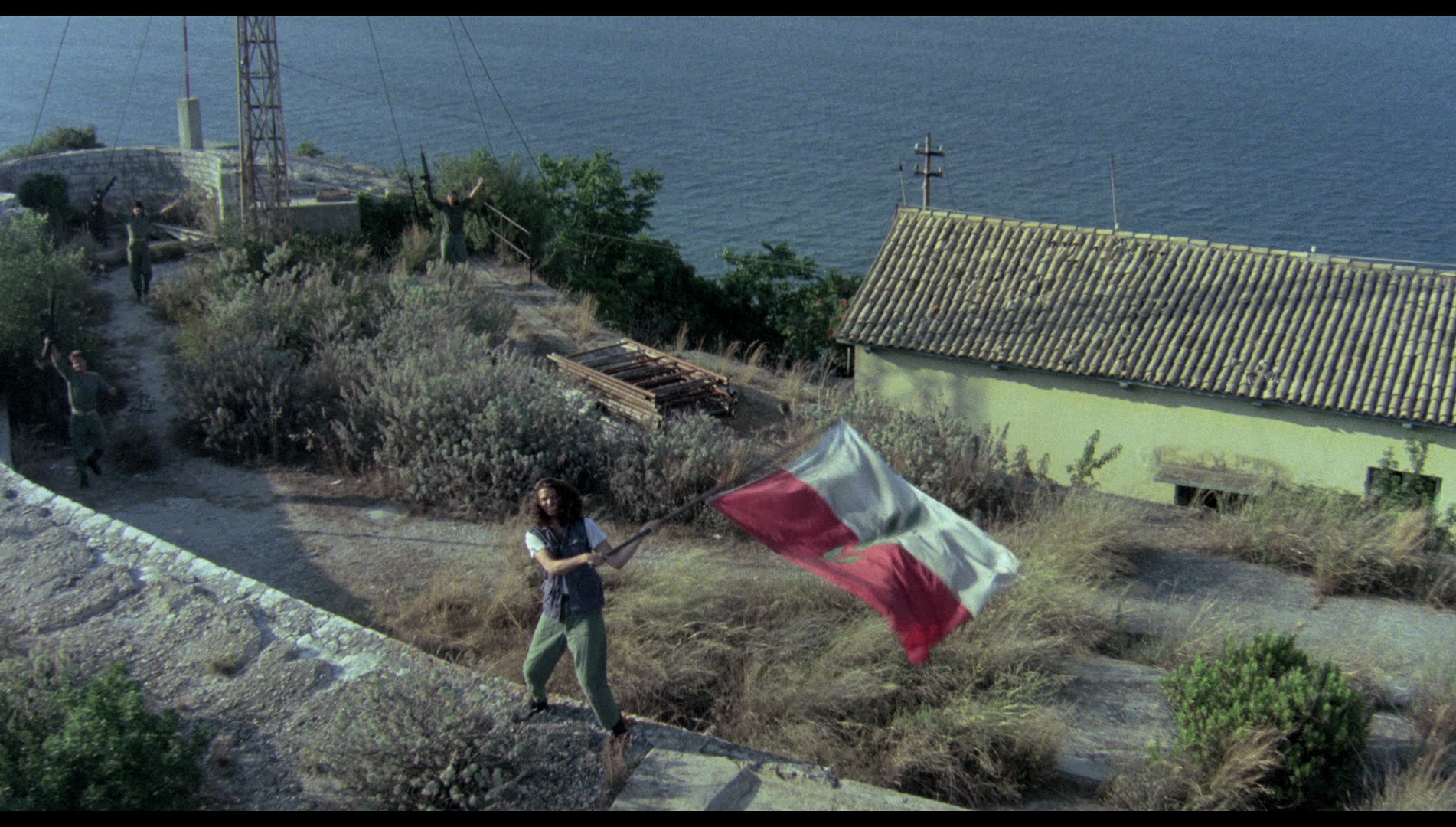 An entertaining action picture of its type, Hired to Kill is, like many of Mastorakis’ films, utterly eccentric. The film features some of the traits of Mastorakis’ other films: an interest in photography, for example, and a cameo from Mastorakis himself (in this film, the director appears in voice only, as a radio announcer). In amidst the action, there are some great, snappy lines of dialogue. In the sequence in which Bartos invites Ryan to dinner, Bartos tells Ryan ‘And to think people still think we’re a backward country’. To this, Ryan asserts, ‘You can never be totally popular or totally right’. An entertaining action picture of its type, Hired to Kill is, like many of Mastorakis’ films, utterly eccentric. The film features some of the traits of Mastorakis’ other films: an interest in photography, for example, and a cameo from Mastorakis himself (in this film, the director appears in voice only, as a radio announcer). In amidst the action, there are some great, snappy lines of dialogue. In the sequence in which Bartos invites Ryan to dinner, Bartos tells Ryan ‘And to think people still think we’re a backward country’. To this, Ryan asserts, ‘You can never be totally popular or totally right’.
In its adoption of the narrative premise of The Dirty Dozen and its casting of women as Ryan’s team of mercenaries, Hired to Kill seems to offer a dry take on the gender politics of 1980s action films, during an era in which action pictures would become increasingly self-aware – ultimately leading to very self-reflexive pictures such as Tony Scott’s The Last Boy Scout (1991) and John McTiernan’s The Last Action Hero (1993). In terms of its depiction of women with guns, the film has some similarities with roughly contemporaneous Hong Kong action films such as Yes, Madam! (Corey Yuen, 1985) and Iron Angels (Kai-Ming Lai, Pun-Hei Lung & Siu-Hung Leung, 1986). The film is packed with the iconography of the 1980s. Hired to Kill is a fun film of its type, and Arrow’s Blu-ray release contains a very good presentation of the main feature that is accompanied by some fascinating contextual material. Overshadowed by Clint Carpenter’s on-set death, Mastorakis’ and Thompson’s reflections on the making of the picture are very interesting, and the commentary with Zetlin is fascinating for its wider focus on Zetlin’s career as an editor on not just this film but many others too. References: Sellers, Robert, 2013: What Fresh Lunacy is This? The Authorised Biography of Oliver Reed. London: Hachette 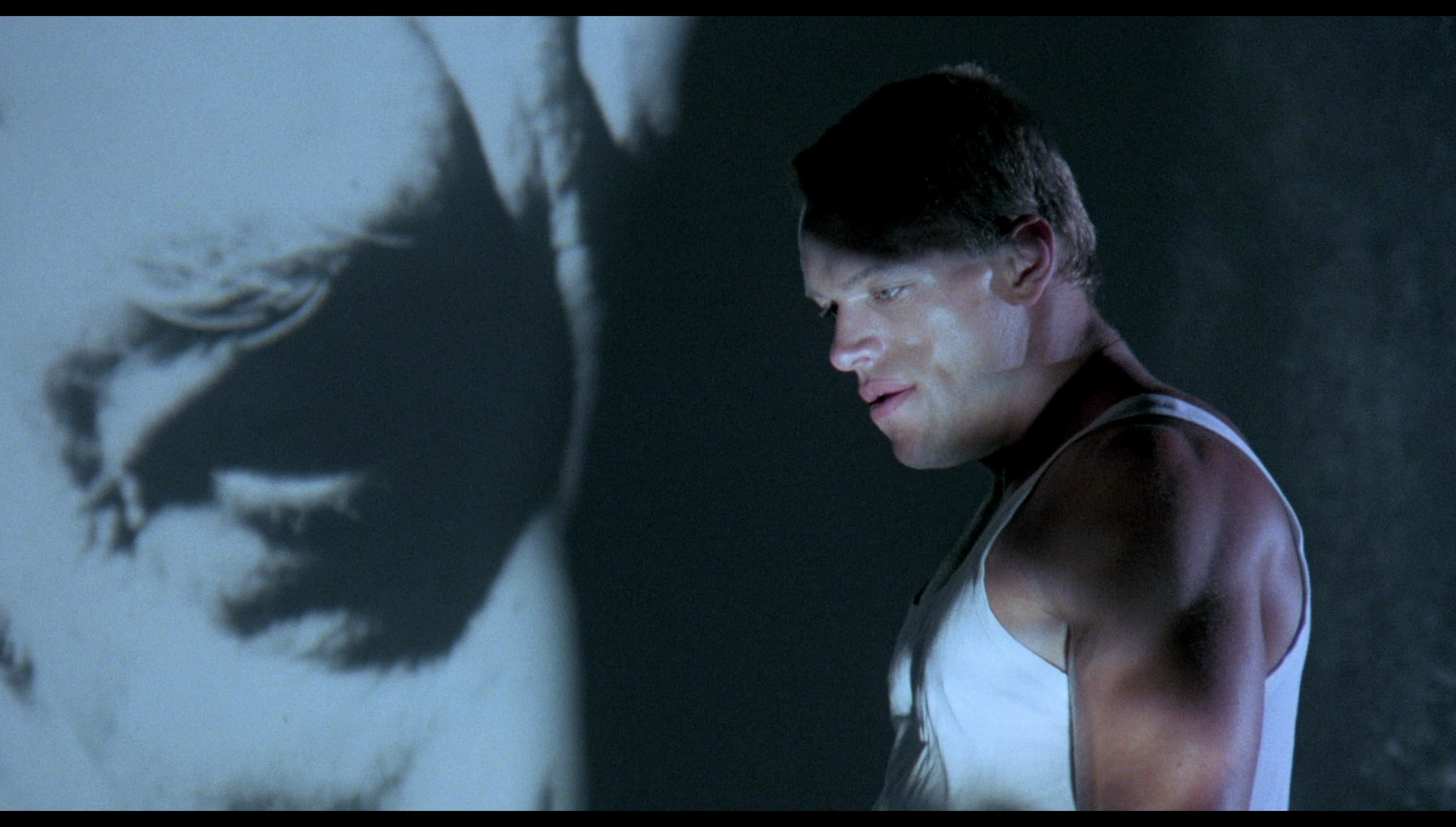
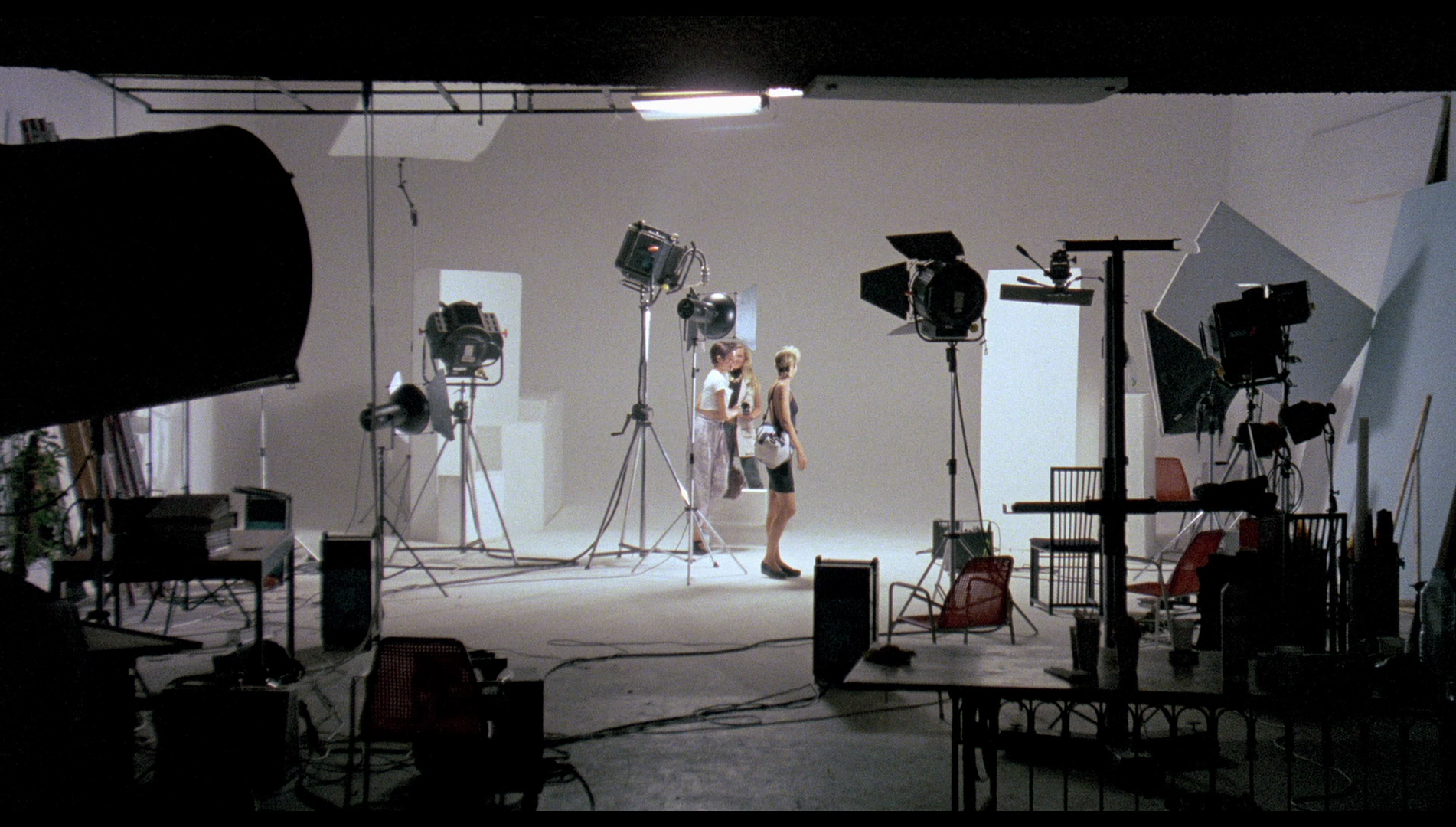
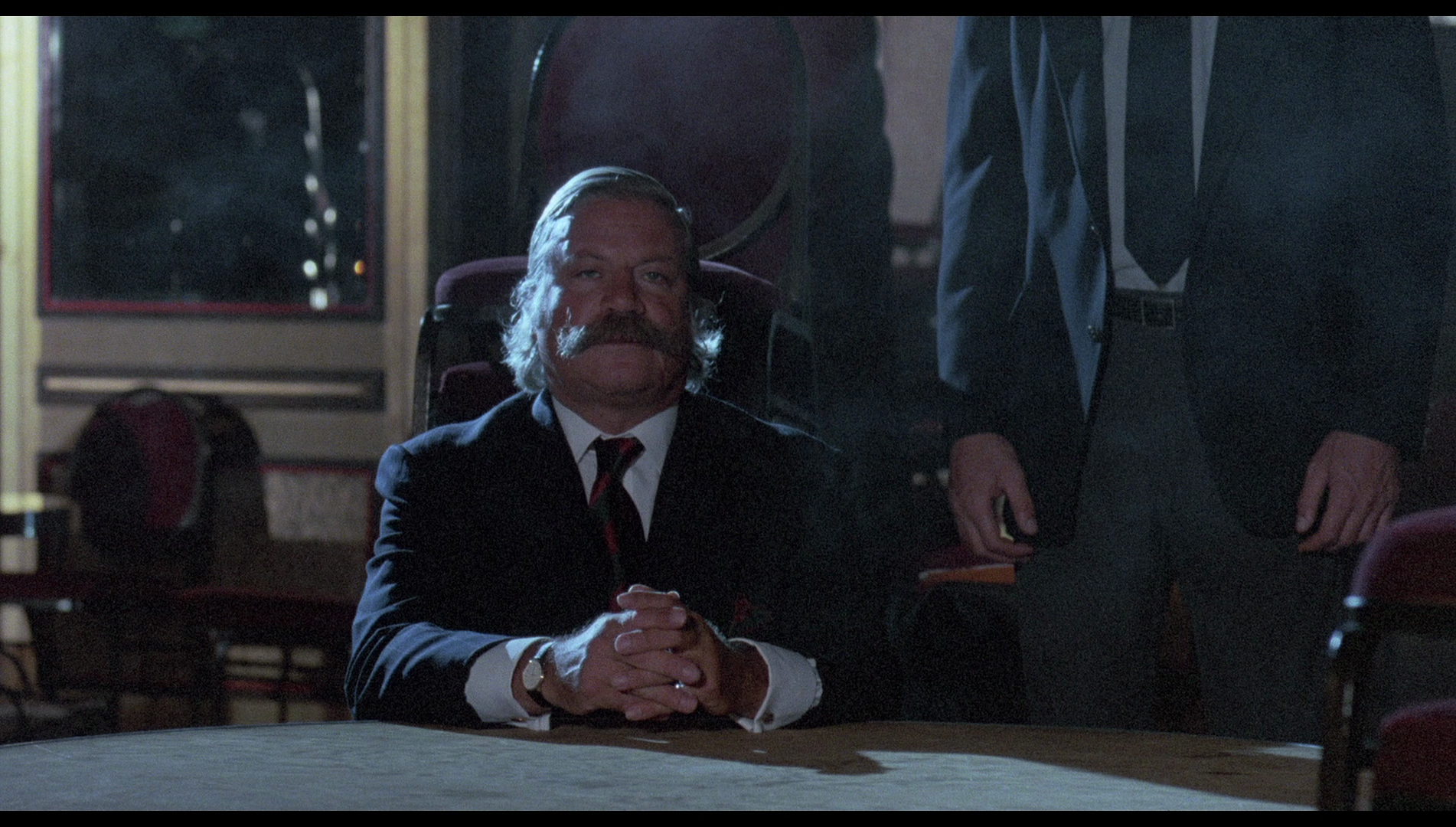
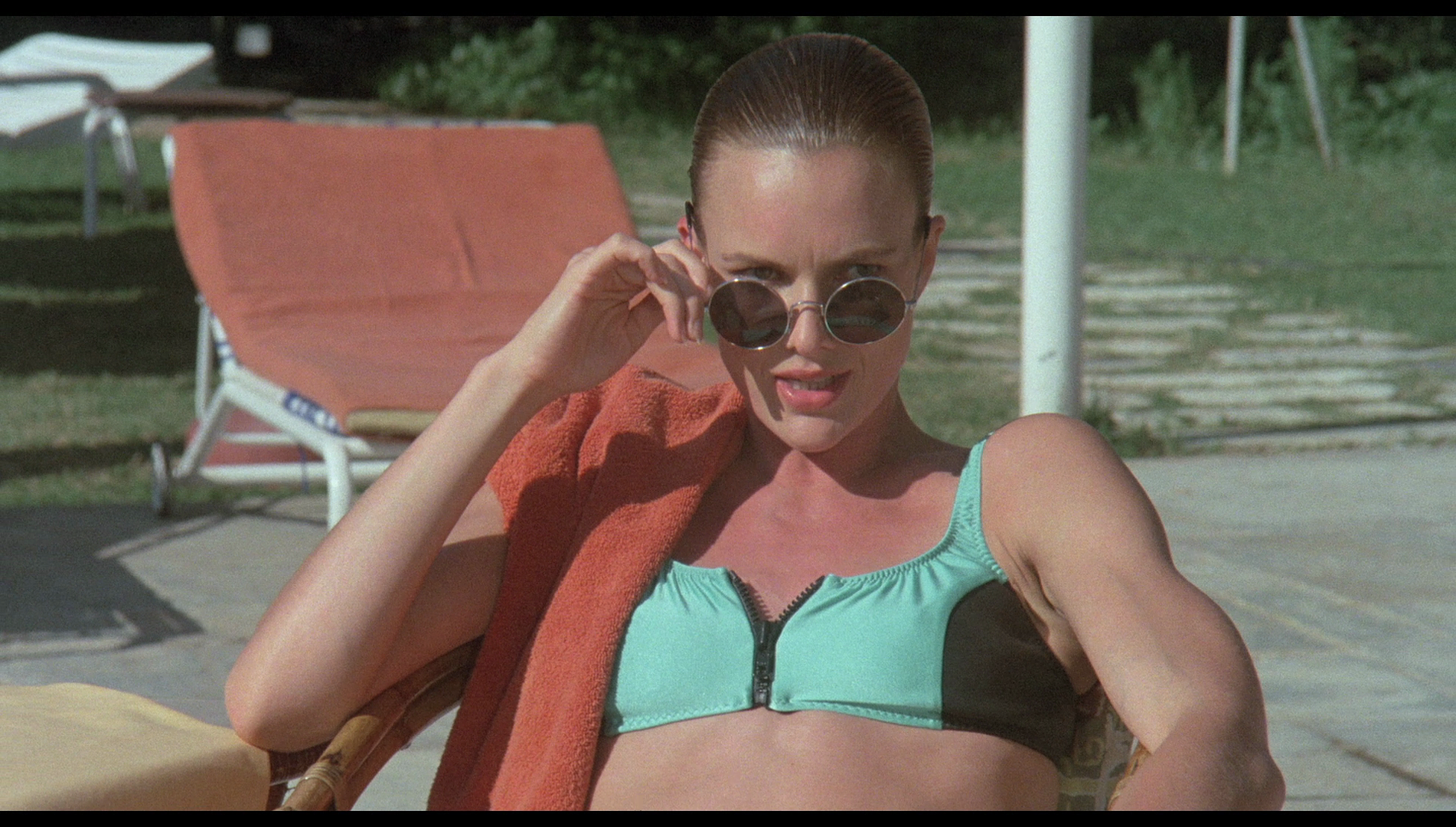
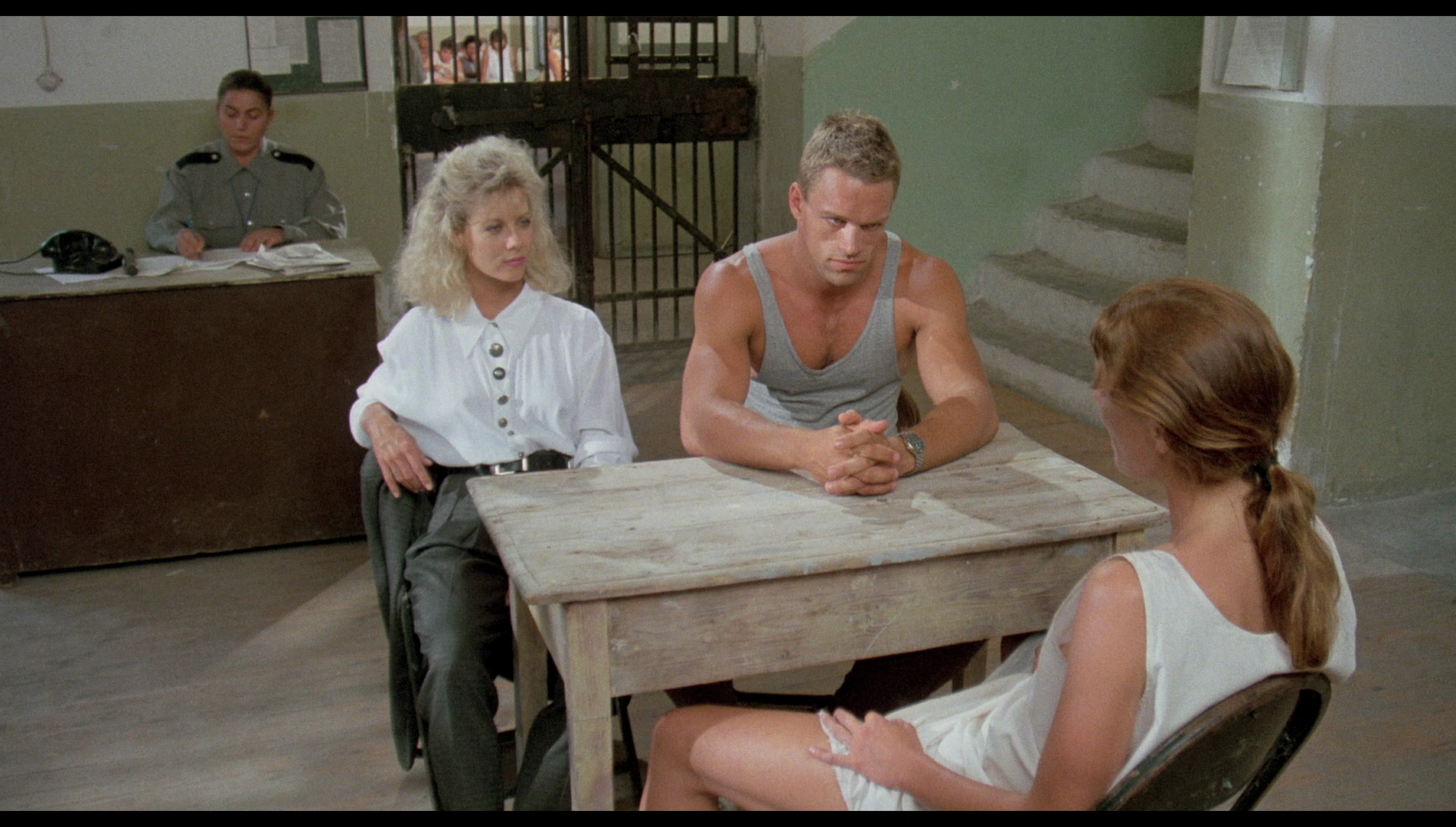
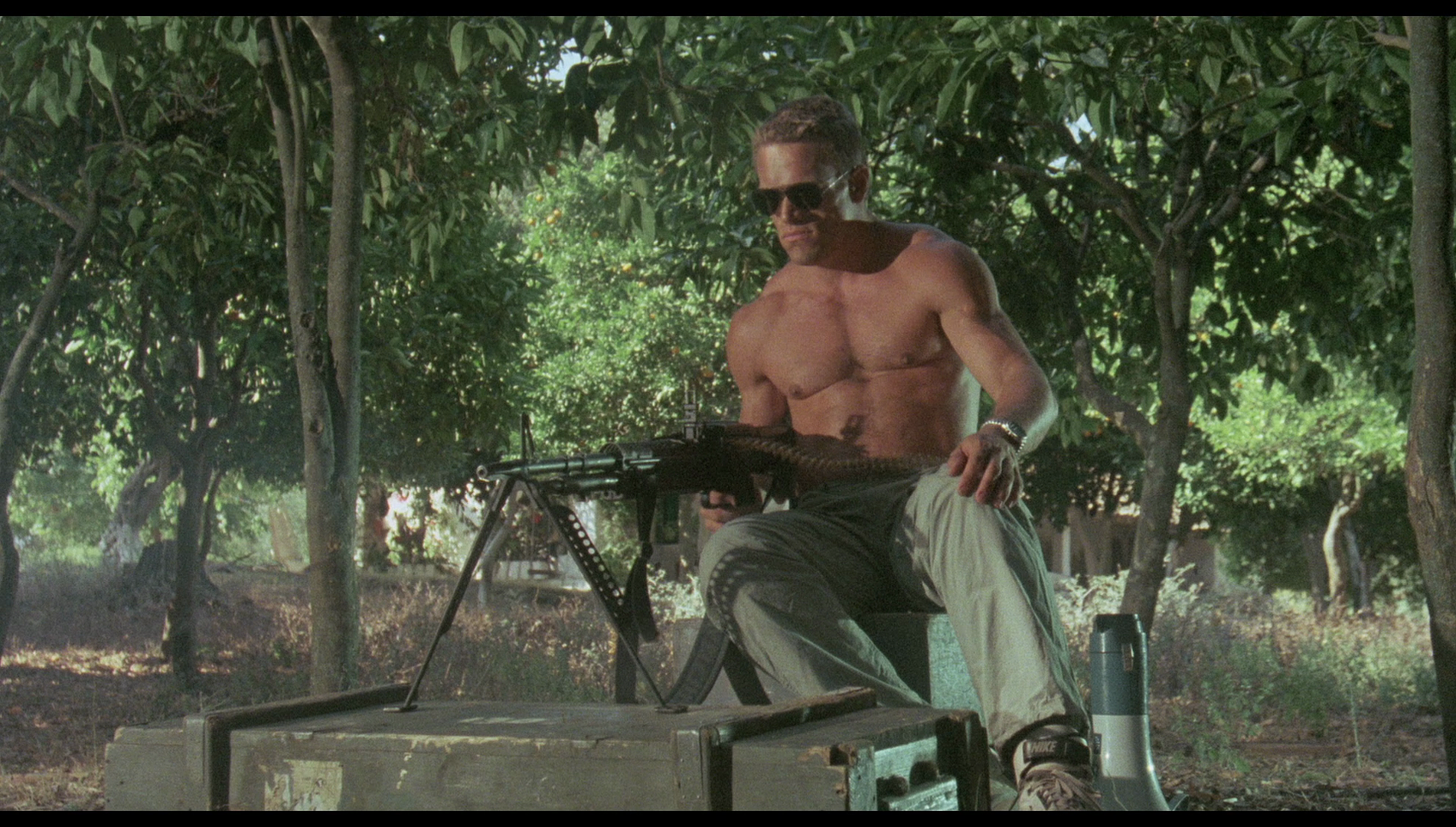
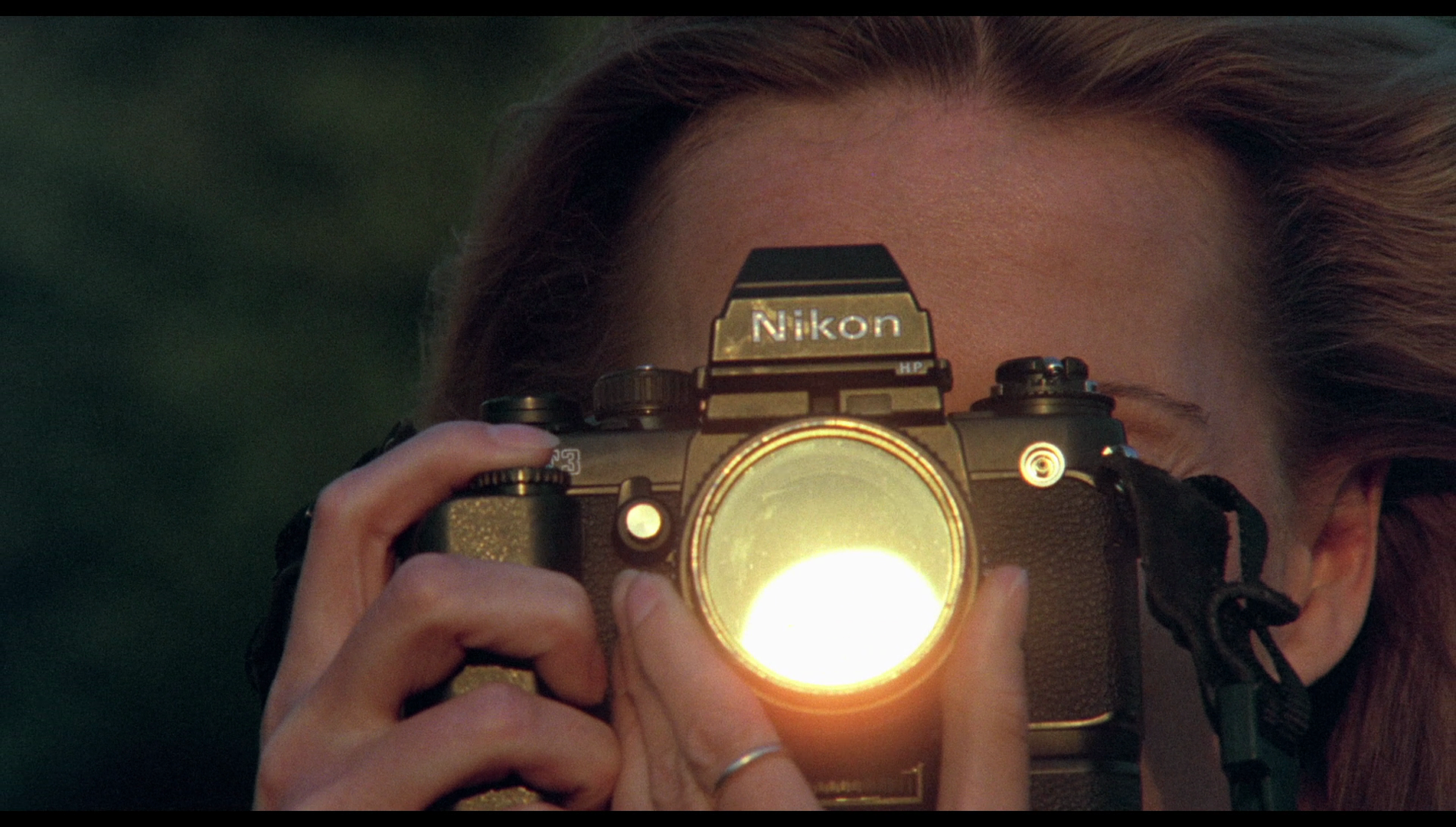
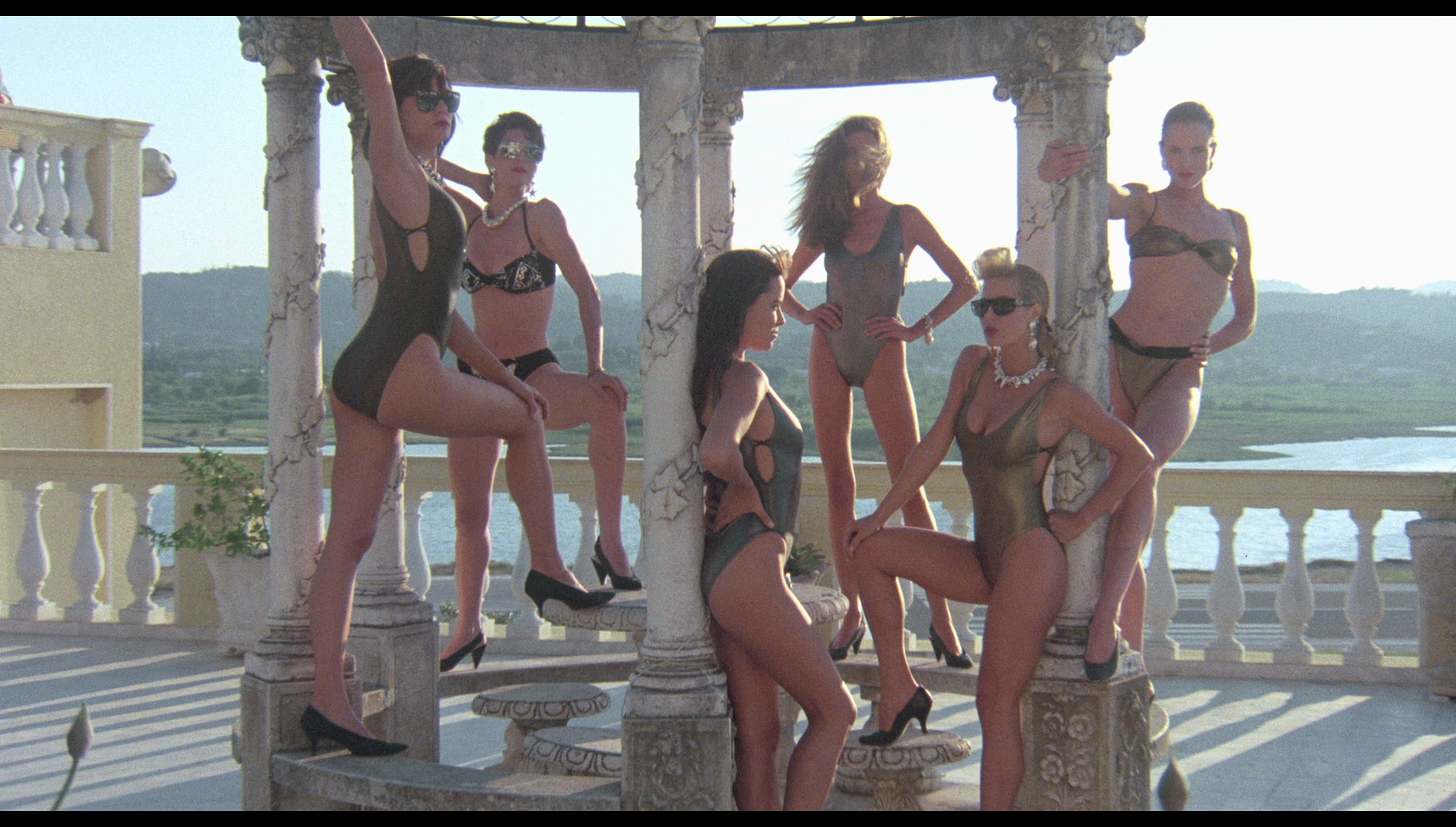
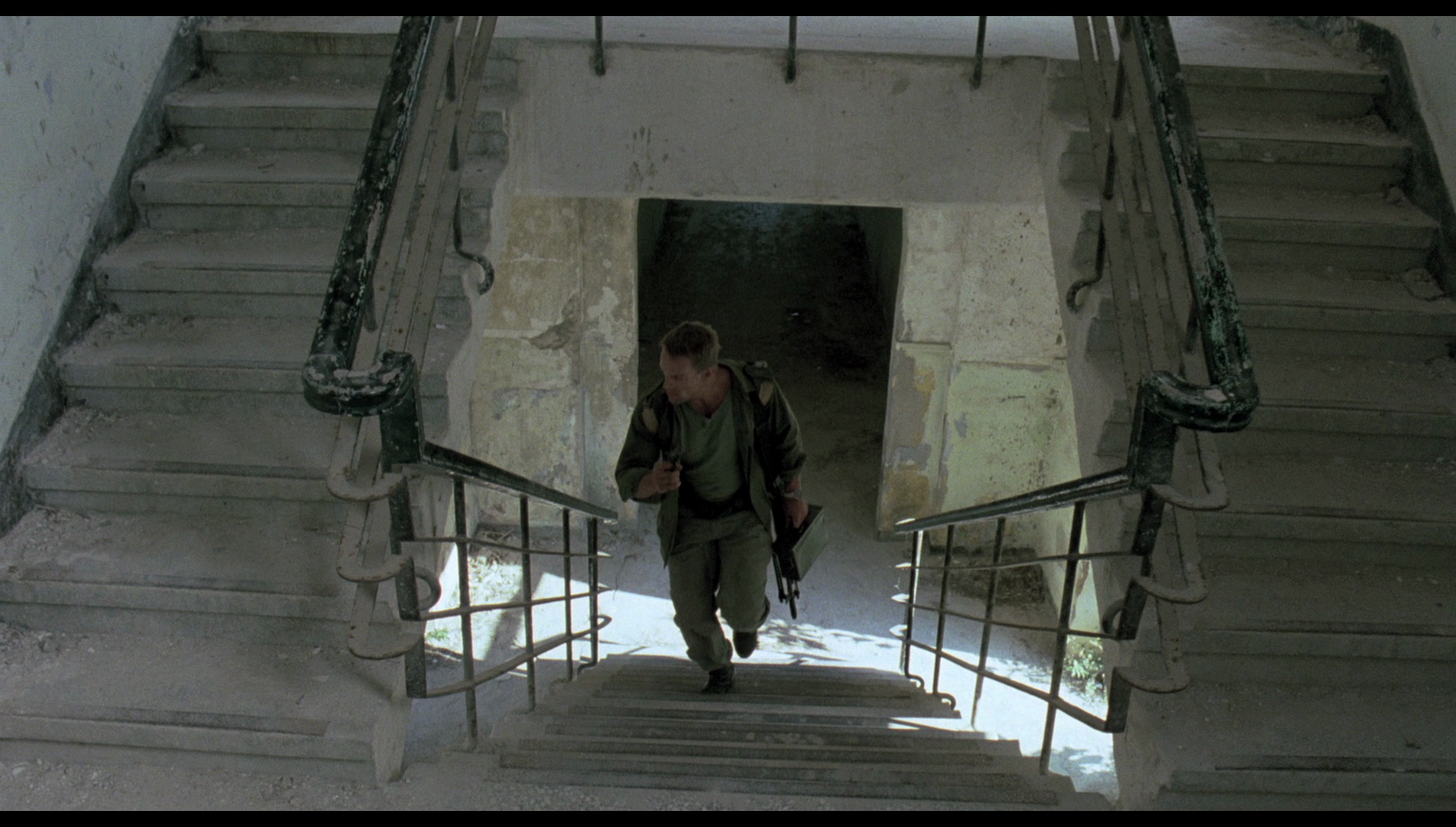
|
|||||

|